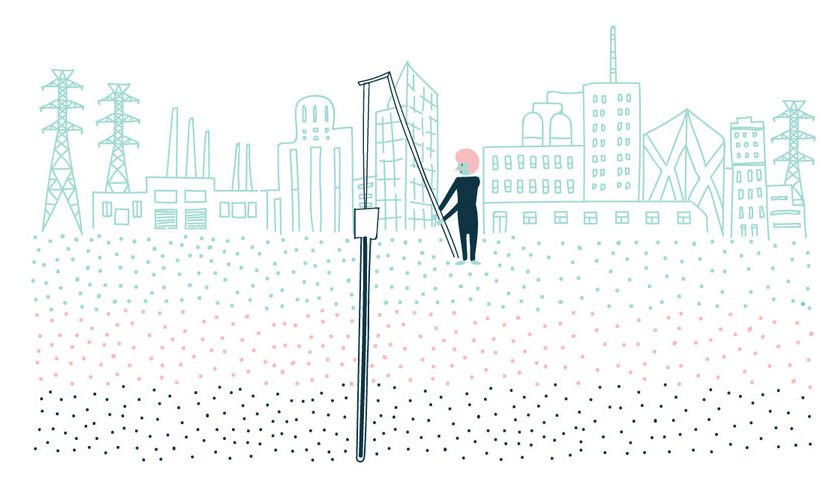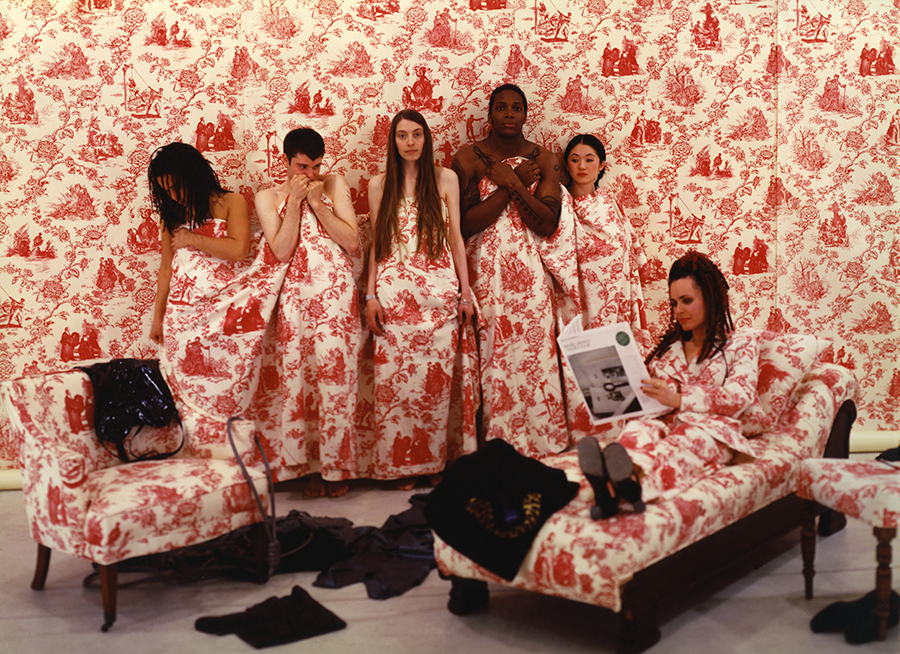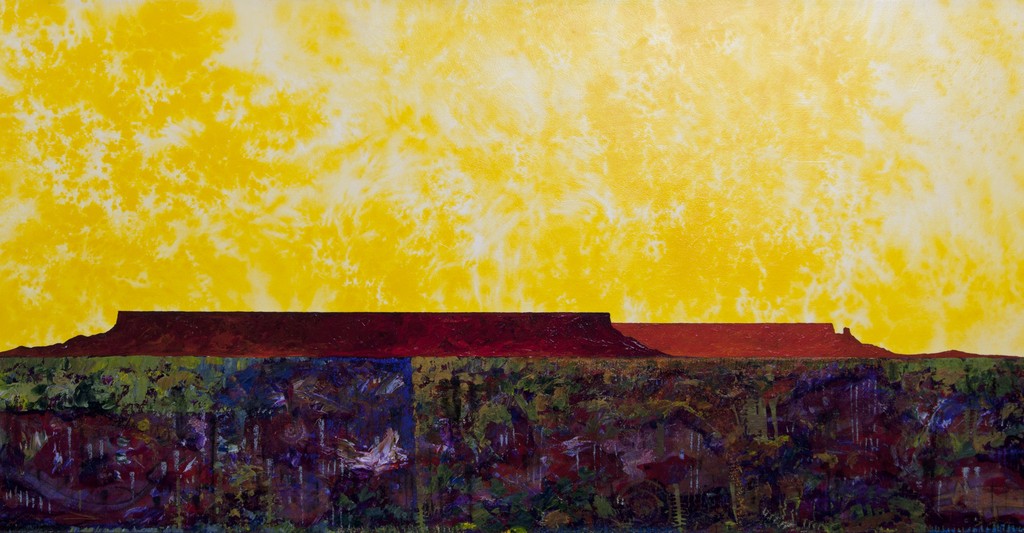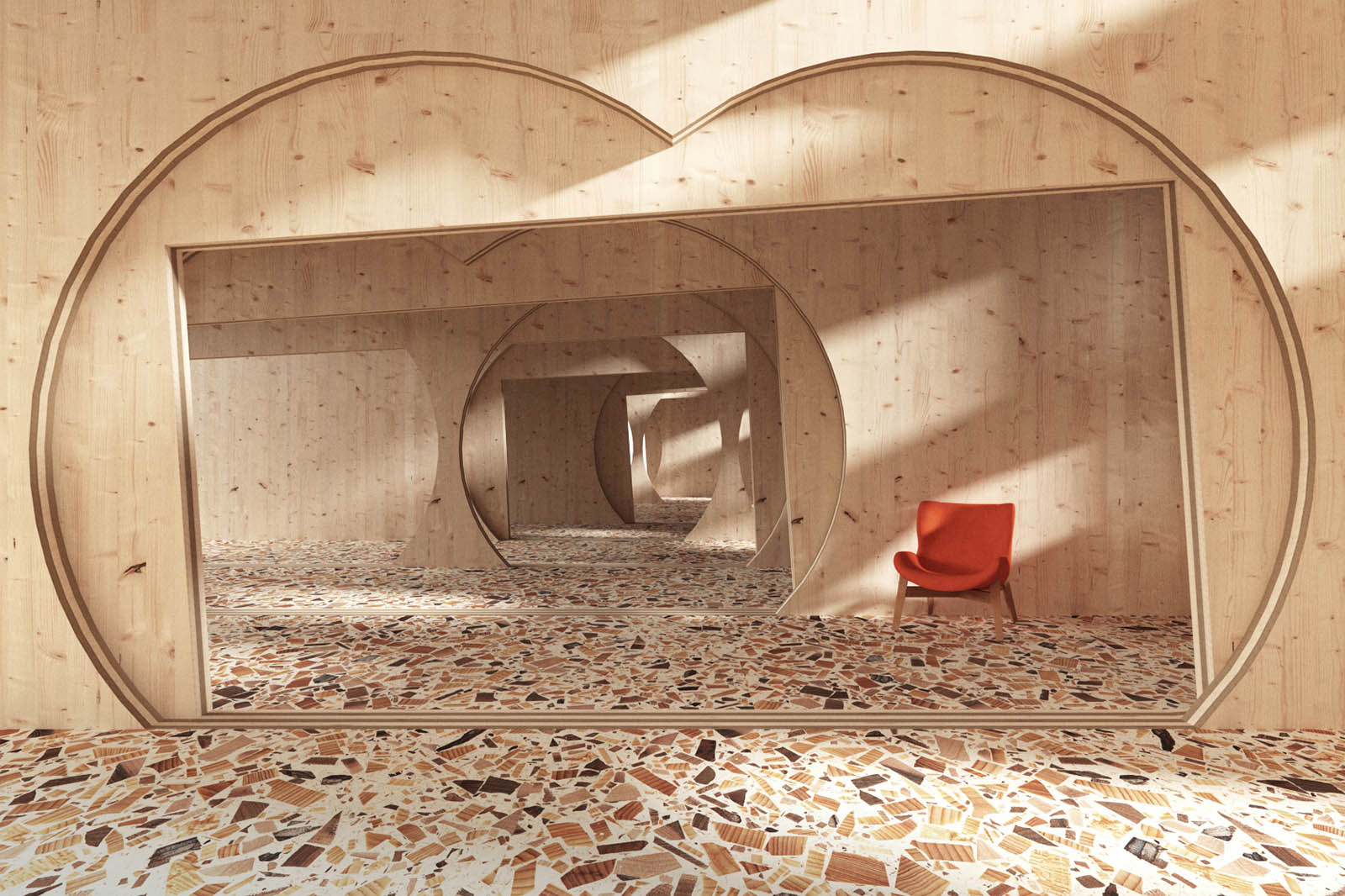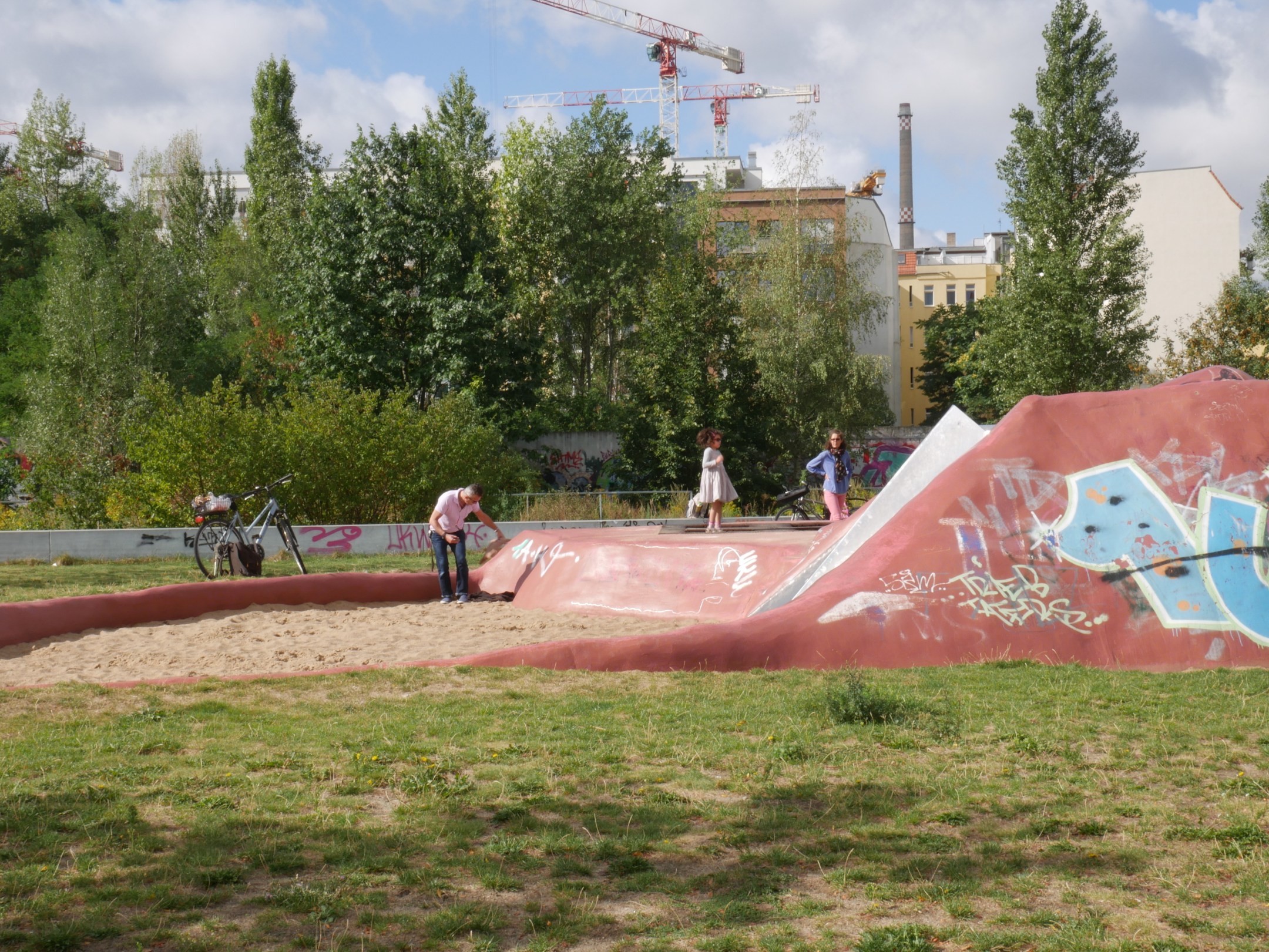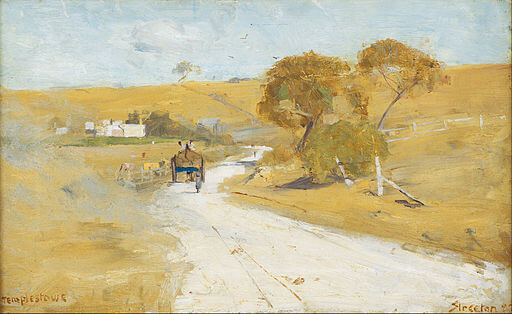Excerpt: Justice from the Ground Up, by Julie Bargmann
Excerpt: Justice from the Ground Up, by Julie Bargmann
“Five years ago, the Harvard Graduate School of Design’s
Just City Lab published
The Just City Essays: 26 Visions of Inclusion, Equity and Opportunity. The questions it posed were deceptively simple: What would a just city look like? And what could be the strategies to get there? These questions were posed to mayors, architects, artists, philanthropists, educators and journalists in 22 cities, who told stories of global injustice and their dreams for reparative and restorative justice in the city.
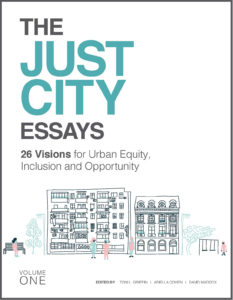
These essays were meant as a provocation, a call to action. Now, during these times of dissonance, unrest, and uncertainty, their contents have become ever more important. For the next 26 weeks [starting June 15, 2020], the GSD and the Just City Lab will republish one essay a week here and at
designforthejustcity.org. We hope they may continue conversations of our shared responsibility for the just city.
We believe design can repair injustice. We believe design must restore justice, especially that produced by its own hand. We believe in justice for Black Americans. We believe in justice for all marginalized people. We believe in a Just City.”
—Toni L. Griffin, Professor in Practice of Urban Planning, founder of the Just City Lab, and editor of The Just City Essays
Justice from the Ground Up
By Julie Bargmann
Soil contamination is a baseline condition for most of the sites I’ve worked on over the past two decades. The toxic imprint derives from industry—steel production, shipbuilding, fabrication of automobile and machine parts, to name just a few—in both urban and rural settings. But it also comes from lead-containing gasoline and paint, banned long ago but still quietly wreaking havoc. It’s a byproduct of the human pursuit of greater material wealth and a more convenient and comfortable life. In other words, it’s the legacy of progress, for better or worse.
As a landscape designer with expertise in toxic remediation and the regeneration of fallow land, the “better or worse” part is vitally important to me. I can say that with certainty, thanks to hindsight and 30 years of academic and professional experience. I didn’t grow up with the term “environmental justice,” which came into use in the 1980s to describe, in part, the unequal distribution of the benefits and burdens of progress. But I now know what a growing body of research shows: in the United States there’s a disturbing overlap between the maps showing where poor people and ethnic minorities live, and where contaminated soils exist.
You might use a stronger word than “disturbing” if you or a loved one were to develop a learning disability, cancer, or liver damage, which are just three of the many proven ill-effects of poisoning by lead, arsenic, and other pernicious elements found in soil. As I write this essay, residents of Vernon, California, in East Los Angeles, a low-income and largely Latino community, were celebrating a bittersweet victory, after forcing the closure of a battery recycling plant owned by New Jersey–based Exide Technologies. The sickening part of the story, pun intended, is that the plant operated for two decades after its environmental violations were first reported to the California Department of Toxic Substances Control (DTSC). Both the cleanup efforts (just 150 of 10,000 contaminated properties were reported to have undergone soil remediation as of early October) and the official response have been weak. “All of us could have acted sooner to develop a more complete picture of what the operations of that facility meant to the health of the residents around it,” DTSC director Barbara A. Lee said. She hastened to add that “the department had tried to shut down the facility in the past but the courts blocked the effort,” according to one published report.
When I read that I chuckled sadly to myself. It reminded me of an exchange I had a few years ago with a high-ranking city official with oversight of a new development for low-income residents I was working on. The developers were eager to start construction, to show “progress,” so they broke ground before testing the soil. Sure enough, the dirt was hot. I had joined the project late, when the momentum to build the inaugural prototype house was unstoppable. But when I learned the test results, remediation was still possible, and regardless, I was bound to report them. I still get a pit in my stomach when I think of the official’s response, which went something like this: The city has enough problems that are plain to see, so let’s not add to them by disclosing a difficult truth, especially one that’s invisible. To my disappointment, the project team elected not to address the contamination, and I was politely excused from the job. Continue reading on designforthejustcity.org…
Bodies in Motion: Jennifer Newsom on foregrounding the kinetic body in architectural representation
Bodies in Motion: Jennifer Newsom on foregrounding the kinetic body in architectural representation
Can you depict a sweating body in an architectural drawing? Are lines capable of expressing the exhaustion felt when climbing a steep incline? And what is drawing’s capacity to represent the effects of powerlessness, fear, and objectification experienced by bodies that feel a space does not belong to them, as, for example, Black bodies too often do in America?
In her fall studio, “
Movements,”
Jennifer Newsom, design critic in architecture at the Harvard Graduate School of Design, asks students to consider such questions which foreground the body—the kinetic body in particular—in architectural representation in order to illuminate problematic assumptions that dominate the discipline’s methods. “Much of my practice focuses on operating in public space and concentrating on the direct and visceral qualities of those experiences,” she says. “In some ways, those concerns can get neutered or left out when we think about architectural representation, which becomes very abstract. It’s important to be rooted and embedded in our own bodies, to acknowledge that we’re not some kind of god behind a curtain constructing spaces for people that we don’t also live in. We’re of the world, and for architects to act like we’re not is a falsehood.”
Who we center as our subject is a really important question when we talk about architecture. Who is it for? Who gets to make it? Whose world view does it help prop up?
Jennifer Newsom
Architectural renderings, and the future constructions for which they serve as a translation, are not inert but prescriptive in that they present permissible orientations for bodies within spaces. In other words, they dictate where bodies can move and how, what they can see and from what points of view, and whether, in turn, those bodies can be seen. Unlike most theatrical scripts, however, in these designs the role of the subject has often been pre-cast long before drawing begins, usually as an idealized white, heteronormative, able, cis-male body. Positioning this subject as central to a design or even as the only possible subject at best effaces those not considered proper subjects or recognizable bodies and at worst facilitates harm, both physical and psychical, against them.
A Cartesian approach would suggest that an inherent and universal truth exists behind the symbols used in such renderings, but phenomenology illuminates the tensions these seemingly benign orientations may contain and subsequently manifest in the built world. “Phenomenology asks us to be aware of the ‘what’ that is ‘around’ [the body],” writes Sara Ahmed, a British scholar working at the intersection of feminist theory, lesbian feminism, queer theory, critical race theory and postcolonialism. Everyone does not engage the ‘what’ identically, though. Ahmed references the feeling of “comfort” as an example of such differences. “To be comfortable is to be so at ease with one’s environment that it is hard to distinguish where one’s body ends and the world begins. One fits, and, by fitting, the surfaces of bodies disappear from view,” she observes fA . For most white bodies in the United States this feeling is de rigueur and accepted as a natural state of being. Whether walking by a police station, entering a concert hall, or running across the street at night, a white body can, more often than not, move through space seamlessly, even invisibly, as it and the space around it mutually influence and interact with each other. Its movements can seem unlimited, and it does not pay attention to being seen or of its ability not to be witnessed.
A Black body—especially a Black body adorned by symbols or moving in such a way marked suspicious by white bodies—is not an actor with power and privilege in the same spaces, however, but an object by which white bodies orient themselves. According to the French-Martinican psychiatrist and philosopher Frantz Fanon, the familiarity with one’s world determines a body’s ability to do and find things. A world that does not engage in a mutually constitutive relationship with its subject, a world in which that body lacks agency, transforms that subject into an object by which others orient themselves. That body becomes an object acted upon rather than a subject with agency, a body lost and unable to find its footing.

Rudolf von Laban (right) and his dancers, Ascona, 1914. Photo Johann Adam Maisenbach. Courtesy Estate of Suzanne Perrottet.
It is in this way, Ahmed argues, that whiteness exists: not as a race codified by perverse scientific fantasies, but as a kind of amniotic fluid through which white bodies and those that assimilate to their codes flow freely. It homogenizes them but also “makes non-white bodies feel uncomfortable, exposed, visible, different, when they take up this space.” Thus a Black or brown body (or a woman) could never assume the role of Baudelaire’s flaneur—the stroller who observes modern society from a detached position. “Who we center as our subject is a really important question when we talk about architecture,” Newsom says. “Who is it for? Who gets to make it? Whose world view does it help prop up?”
One of Newsom’s goals in the studio was to make students acknowledge up front that subjectivity and the experiences it does and does not enable affects the work they do. In order to facilitate that awareness and how it manifests in design, she asked students to perform walks in their environments, which were varied because of distance learning. “I gave them a list of prepositions such as
on, between, against—words that are a kind of bridge in language and that have a spatiotemporal aspect,” she explains. “They picked five words and used them as intentions to guide their movements. They then made drawings representative of these qualities.” The objective was to make students aware of their own privilege or lack thereof, especially in public space, and of which spaces were and were not available to them. “It’s been interesting to hear them reflect on what’s afforded to them by their different environments and to use that experience as a provocation to think about race, the ableness of the body, gender, and the intention of a body in any particular space. You don’t build empathy outward if you don’t have a self-reflective capacity.”
Consider, as an example, the preposition
out of in relation to the Jefferson grid. Embodying Enlightenment ideals of imposing order on what was deemed an untamed landscape occupied by “savages,” the grid became a tool of settler colonialism in its attempt to dominate land that did not belong to them. Furthermore, the grid’s straight repeated lines—a declarative and predetermined cartography—illustrate power’s resistance to discomfort, surprise, and uncertainty by its elimination of difference. Anyone who did not capitulate to this form could be cast as a renegade and improper—even wild. Its straight lines also facilitate clear sight lines which, as Jeremy Bentham’s panopticon illustrates, can in themselves pacify bodies into obedience through a persistent assumption of being visible and therefore watched.
It is a challenge, then, to put oneself
out of view in the grid, to resist visibility, without the risk of being othered and turned into an object. The modern surveillance state has turned our spaces into a grid writ large and has made invisibility, in this sense, almost impossible. As a result, we have all been objectified in a way—though some more so than others. But how often is surveillance’s omnipresence, whether the literal vectors of security cameras and their phenomenological effects on individuals moving through space (stress, fear, etc.) or simply as a quality inherent to the grid, incorporated into architecture renderings?
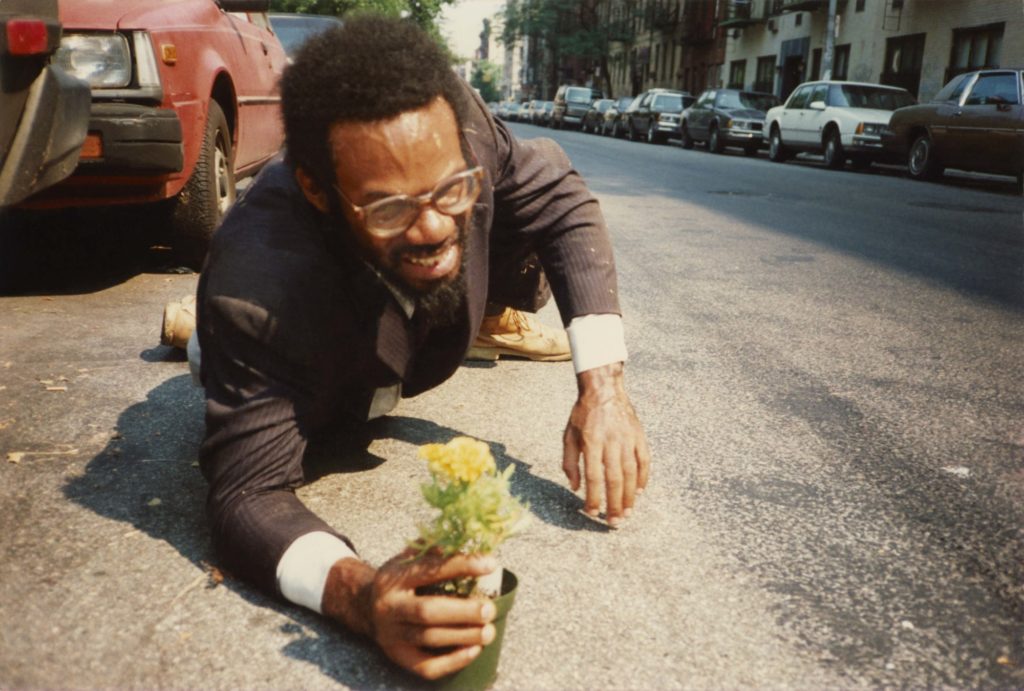
Pope.L, “Tompkins Square Crawl,” (1991). Courtesy The Museum of Modern Art.
“If there’s a reliance on the truth of the line, how do we subvert that in some ways? Is it something about a density of marks? Redaction? A lack of visibility? A refusal of interpretation? Whether it’s fine to be oblique and not communicate? How do we layer the accretions of time, the fluidity of movement, its staccato rhythms, in the space of the drawing?” asks Newsom. Her students’ translations of their walks suggested novel responses to these questions of representational possibilities and limits in drawing. “Some are developing a kind of notation, almost like Laban dance notation, in which they make correspondences between movements and marks,” she says. “Others are looking at stereoscopic vision—the fact that we have two eyes. Those students did an interesting animation which explores moiré effect and the way in which our eyesight involves light hitting two receptors and the brain processing it in order for us to understand the three-dimensional world.”
As a further effort to inspire alternative possibilities in representation, Newsom then asked students to engage with a diverse group of artists whose work challenges hegemonic flows through movement, film, dance, and photography, as well as drawing. For example, for decades, the American artist William Pope.L performed long-distance crawls throughout New York City and Europe. In
Tompkins Square Crawl (1991), he wore a business suit while carrying a small potted plant, as if he were on his way to work. The piece illuminated that just to crawl—to refuse walking, verticality, and thus the dominant point of view and means of mobility in society—was enough to disrupt, to draw attention, and even to have movement stopped. In fact, an onlooker became so irate that he called the police.
Renée Green also plays with our ability to ignore the visible in her 1992 work
Mise-en-Scène: Commemorative Toile. By appropriating the 18th-century toile fabric tradition, which was produced by colonized peoples and often depicted colonizers and the colonized alike in bucolic scenarios, Green comments on Empire’s violence and its effacement of the Other. From a distance, Green’s delicate floral patterns seem to preserve toile’s traditional pastoral peace. Upon closer examination, however, one sees the lynching of a Frenchman, an enslaved Black man chained and kneeling in front of a white man, and other brutal scenes. The work could be read as a castigation of actions that purport to acknowledge problems but suggest no systemic changes—literal window dressing that asserts surfaces’ capacity to preserve power and the need for change to be more than skin deep.
Conversely, Janet Cardiff engages with the non-present and invisible in the scripted, choreographed walks she produces with George Bures Miller, such as
Night Walk for Edinburgh (2019). Participants are guided by Cardiff’s voice through headphones from which myriad street noises also emanate as they follow a prescribed path through the city. They hold smartphones which play scenes from a film shot on the same streets they traverse—a woman running down an illuminated path; drunk men singing as they pull a man, perhaps dead, on a trolley—creating a kind of augmented reality. Cardiff describes the experience as similar to that of recalling a dream when you wake up, with various scenes and characters that you might remember in full or just in pieces.
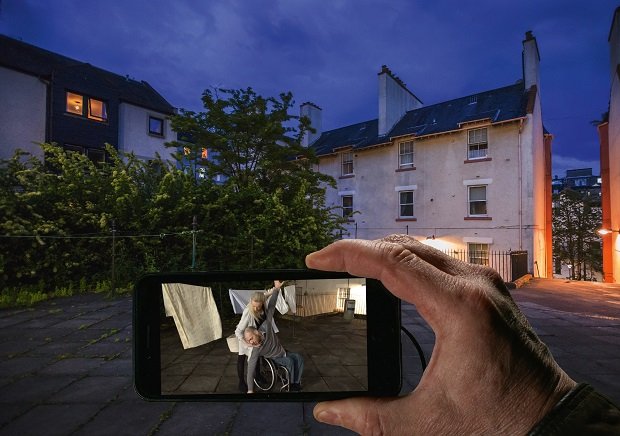
Location photograph for “Night Walk for Edinburgh,” (2019). Courtesy Janet Cardiff and George Bures Miller.
By incorporating a sense of play into these interactive performances, and paradoxically through the use of technology, Cardiff compels us to pay closer attention to our physical environments, and specifically to absences therein. Through the haunted and haunting medium of film, she makes explicit that our environments are archives of memory and receptacles of loss. From a design perspective, her films prompt questions regarding the acknowledgment of time passing, such as the continual attempts to erase historical memory through repairs of surfaces as opposed to allowing them to reflect the passage of time. They also examine the continual attempts to erase such memory through repairs of surfaces, as opposed to allowing these surfaces to reflect the passage of time.
In part due to film’s incorporation of time—which separates it from drawing—Newsom assigned students to synthesize what they learned from their earlier explorations by creating short films using their own prompts, with a maximum length of three minutes. “In my practice, we do a lot of collaborations with filmmakers as a way to help us reinterpret, more deeply understand, and interrogate our work, but much of that happens after our installations are built,” she says. “I was interested in seeing what would happen if film is foregrounded in the architectural process, in what ways it could comment on how we represent, say, weight, slowness, effort, or exertion, and how those actions interact when executed in space as well as how others react to them.”
With these varied exercises Newsom hopes to inculcate a heightened awareness of the unconscious and conscious attitudes and tools that students bring to their work. “This is one of the last advanced studios for students before they do their theses,” she says. “They’ve been given an inheritance through their education to this point, and I’m asking them to think about what they do with it.” This “inheritance” is akin to Marx’s theory of history. “Men make their own history, but they do not make it as they please; they do not make it under self-selected circumstances, but under circumstances existing already, given and transmitted from the past,” he writes in
The Eighteenth Brumaire of Louis Bonaparte. “We’re all physically in the world and are taking in the directness of experience in the moment, but we also bring our inheritance with us into those spaces,” Newsom continues. “Operating as a designer is no different. There’s a physical reality of what you’re creating but there’s also the intention that you bring to it and the inheritance that it carries with it before you’ve even arrived. There are physical and material realities of the world and conventions in which we operate, but the question is how we work with, alongside, and against them.”
It would be too idealistic to say that we can refuse the gifts of inheritance. Resisting and transgressing the expectations of the gift giver, however, is a conscious act, and an act that we ignore at our peril.
This Land Is Your Land: Students interrogate why “urban” and “Indigenous” are cast as opposing identities
This Land Is Your Land: Students interrogate why “urban” and “Indigenous” are cast as opposing identities
Until the last decade, Native American, First Nations, and other Indigenous architecture has been a glaring gap in North American architectural discourse. The increased recognition of Indigenous peoples and their continued push for self-determination, however, puts a spotlight on land use on Indian reservations and in other areas with large Indigenous populations.
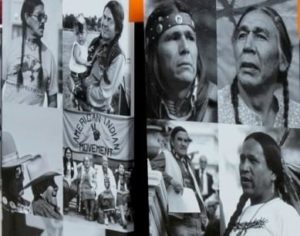
Image from NACDI Leadership Training Program: An annual training program focused on developing highly skilled and committed Indigenous leaders.
, associate professor in practice of urban planning at the GSD, asked students to engage with Indigenous architectural issues in two sequential studio modules this term. The first—
“This Land Is Your Land”—focused on Minneapolis, which was built on land stolen from the Dakota tribe.
Minneapolis’s Native American Community Development Institute (NACDI) hopes to bolster the growth of the country’s only America Indian Cultural Corridor in a city home to one of America’s largest urban Native American populations. The second studio (which is still in progress)—
“As of Right: First Nations Reclaim the City”—looks at British Columbia, where the Squamish Nation seeks to build diverse new projects on its undeveloped reserve land, including 11 acres of the former fishing village Senakw, which lies within Vancouver.
Historically, “urban” and “Indigenous” have been cast, psychically and physically, as opposing identities. Indian reservations in the United States—of which there are about 300 in 36 states, comprising over 50 million acres of land—were intentionally situated away from metropolitan areas and especially in areas not deemed desirable by white populations. This enforced isolation reinforced the long-held colonialist project, both conscious and unconscious, of removing these societies from those of the settler colonialists by separating them from roads, cities, towns, and, in some instances, natural resources. While the Indian Relocation Act of 1956 brought more than 100,000 Native Americans to urban areas, it did so with an assimilationist agenda. It sought to eliminate Native American identity through the intentional severing of family and community ties which the federal government saw as counterproductive to promoting American nationalism after World War II.
“Conservative terminationists [the term used to describe those who supported these assimilationist policies] saw traditional Indian communal social structures as too similar to the dreaded communist systems that they perceived the United States to be in conflict with during the Cold War,” Larry W. Burt writes in American Indian Quarterly. “Separate governmental and landholding status, federally-supplied services, and the continuation of the Bureau of Indian Affairs itself violated a politico-economic system based upon individual property rights and private enterprise that conservatives saw as the foundation of the American system.” Today, up to 72 percent of Native Americans live in urban areas, where they experience nearly twice the rate of poverty, unemployment, and under-education as the general population, with outsized homelessness rates as well.
In Canada, over half of the Indigenous population—First Nations, Métis, and Inuit peoples—live in cities. They, too, have historically been subject to a holocaust and the systematic annexation of their land—in large part, a result of the Indian Act passed by Canadian Parliament in 1876. The edict prohibited First Nations peoples from freely leaving their reservations, forming political organizations, speaking their native languages, and practicing their religion. Key to the federal government’s intentions to eradicate First Nations identities was the establishment of the residential school program, where abuse was also prevalent. A Truth and Reconciliation Commission formed in 2008 declared these schools a practice of cultural genocide.
The two countries’ relationships with Indigenous peoples have distinct differences though, particularly concerning land rights. Ninety-five percent of the land in British Columbia is “unceded,” meaning it has never been the subject of a treaty that gave it to settlers. “The City of Vancouver have been pretty progressive in some ways by acknowledging that the land is the property of the Musqueam, the Tsleil-Waututh, and the Squamish Nations. There is also a treaty process in British Columbia aimed at resolving First Nations’ claims,” D’Oca says. “Additionally, there are examples of First Nations reclaiming land through litigation and direct action, like in the case of Senakw, which is on highly developable, highly valued land in the middle of Vancouver. Because it’s an IR and Squamish administered, it’s not subject to zoning or the typical review process. Basically they can do whatever they want with it, which is why my studio is called ‘As of Right.’ While there remains a ways to go regarding these lands, this is a precedent-setting project and exciting that a First Nation was able to reclaim land in a major city. It may be a preview of what’s to come in the States.”
Considering this violent and exclusionary history, concerns about non-Indigenous architects working on Indigenous-related projects are legitimate. But these may be overcome through understanding and cooperation. The former begins with acknowledgements of recognition—of cultural identities and land ownership. “‘Native American’ is a huge umbrella term that in some ways has very little meaning,” D’Oca acknowledges. “The differences between tribes in the States and between the Nations in Canada are just as important as their similarities.”
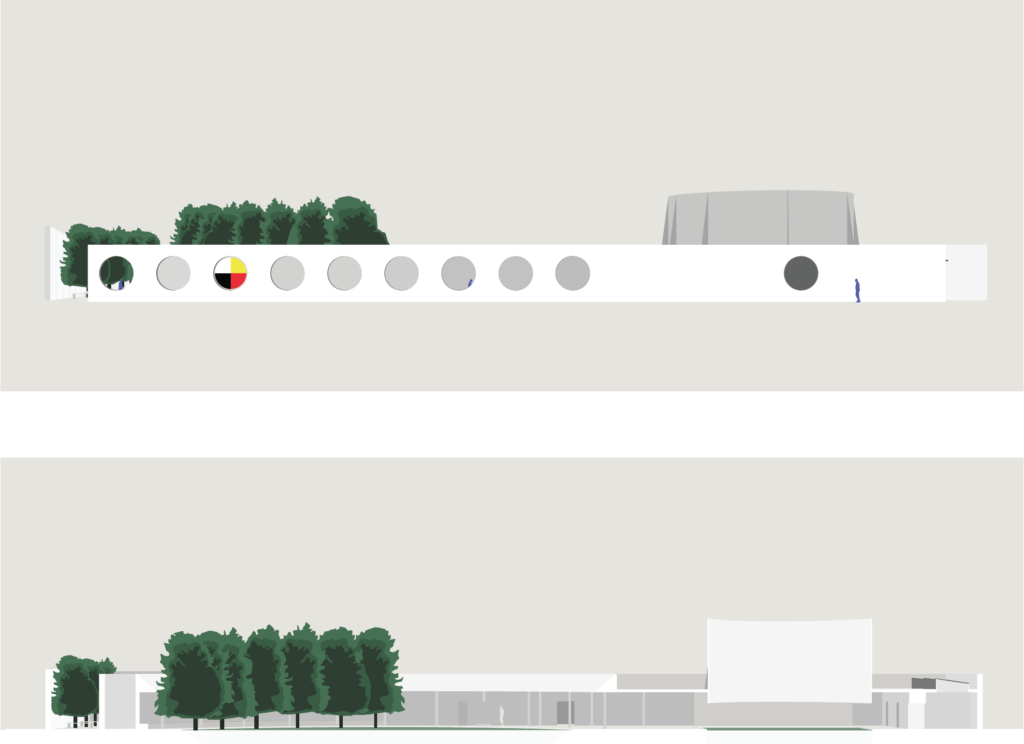
Elevation and Section by Kyle Winston(MArch I ’22) for “This Land Is Your Land,” Dan D’Oca Urban Planning and Design M1 Studio
In terms of cooperation and collaboration, the most productive genesis of a project is an invitation from a community. “I believe strongly in the philosophy ‘nothing about us without us,’” D’Oca says. “In my classes, we always strive to do as much engagement as we can with people who hold diverse opinions. For both studios, we set up a series of discussions with people who work in the neighborhood, leaders who are in touch with the desires and needs of the people in the community, and our client.” For the Minneapolis module, this included
Louise Matson, executive director of the Minneapolis-based Division of Indian Work;
Kelly Drummer, President of MIGIZI Communications, a local Native multimedia arts and youth mentorship organization; and Becky Wolf, a community embedded librarian at
Franklin Library, located on Franklin Avenue which serves as the principal artery of the
American Indian Cultural Corridor. “I don’t let students pick a project until we’ve heard a lot of different voices,” D’Oca says. “The idea is for students to listen, hear what the problems are and what people are working towards, and figure out what they can do to help.”
“These courses teach students how to engage in respectful dialogue,” says Heidi K. Brandow, a founding member of the Harvard Indigenous Design Collective (HIDC) and one of D’Oca’s teaching assistants. “The students are learning how to develop these kind of relationships, to listen, to work in tandem with these communities, and also to learn and understand Native communities’ contributions to the land from design, architectural, and planning perspectives. These conversations could potentially lead to long-term solutions.”
Also key to avoiding a practice of architecture-by-imposition that continues the violence and paternalism of settler colonialism is the studios’ engagement with goals brought by the stakeholders themselves. Unlike the Bureau of Indian Affairs and the Department of Housing and Urban Development, which long instituted plans that did not address the culture and needs of those who occupied those spaces, D’Oca’s students work from ideas suggested by locals. “For the Minneapolis module, NACDI had composed a document that expressed the priorities of the Native peoples from the neighborhood,” D’Oca says. “We knew they wanted an Indigenous farm, a center for Indigenous cosmology, job training, better transportation, and affordable housing. As a result, students were able to say, for example, ‘I know something about affordable housing, and while I’m not going to be the one to put the shovel in the ground, I can help move the needle.’”
Kyle Winston (MArch I ’22) drafted a solution to the separation of urban life and ceremony. He cites a decades-long ban in Minneapolis that pushed Indigenous peoples to the countryside to perform their sacred rituals as a principal reason for NACDI’s request to bring ceremony into the cultural corridor. Winston’s project calls for the creation of “new grounds circularly inscribed within a rectangular site on Franklin Avenue” which include a mix of gathering and sacred spaces. An initial opening in the southeast corner invites anyone, Indigenous and non-Indigenous, to enter, while paths lead toward the site’s center where, he details, “[In] a cloistered garden, three of the four sacred medicines are grown: tobacco, sweetgrass, and sage.” In this space, “an exaggerated soffit directs one’s attention down to the plants, while up above, the sky is pushed away [and becomes] an object of contemplation.” “Red cedar trees (the fourth sacred medicine) frame the ceremonial activity, buffering the city’s hum beyond,” Winston continues, furthering the blend of publicness and privateness in an architecture that resists turning ceremony into a tourist attraction while also educating the uninitiated.
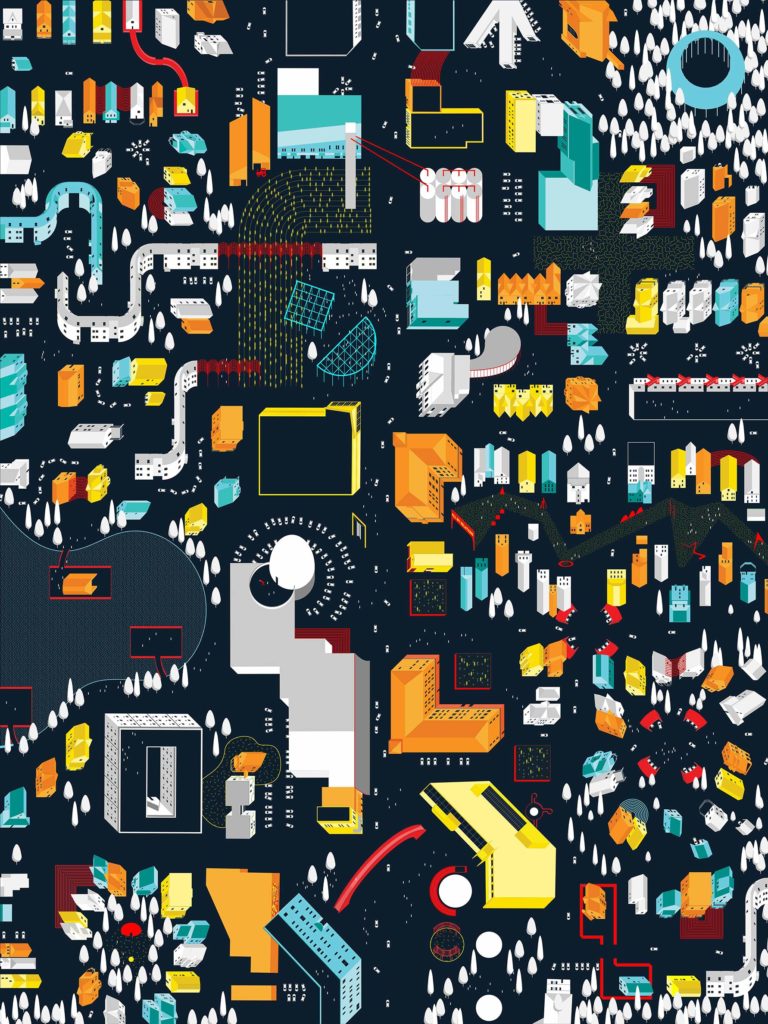
Map by Rachel Coulomb (MArch I ’22) for “This Land Is Your Land,” Dan D’Oca Urban Planning and Design M1 Studio
Rachel Coulomb (MArch I ’22) drafted a more speculative proposal by interrogating the colonizer’s violence against Indigenous peoples using property lines. “The Dawes Act of 1887 authorized the federal government to break up tribal lands by partitioning them into individual plots. Only those Indigenous Americans who accepted the individual allotments were allowed to become US citizens,” she notes. She proposes turning the land into a community trust instead, “where future programming is an agreement among those that live there, and power is placed back with the people through an environmental and social stewardship model.” The result, Coulomb argues, would be a “counter-cartography” that turns Minneapolis into “an expression of generational Indigenous values” and the map into “a depiction of stories” rather than an enemy.
Beyond the respect for the stakeholders in the community this approach entails, it also promotes a tempering, or even dissolution, of ego for architects and designers—an ethos that could be adopted in all interactions with clients, especially with those from cultures unfamiliar to one’s own. A new mode of design that speaks to architectural concerns broadly, with which non-Indigenous designers can provide assistance, while upholding specific cultural traditions may emerge as a result. Such creative collaboration, grounded in dialogue—and, arguably more importantly, listening—can synthesize diverse perspectives and lead to mutual education and growth for both Indigenous and non-Indigenous groups. “Pooling our resources at the GSD to create solutions is mutually beneficial,” says Brandow. “The Native communities benefit from hearing about these proposals, and I hope that the students will walk away with a deeper understanding of Indigenous people and will want to continue working with them.”
With Mass Timber and the Scandinavian Effect, Jennifer Bonner and Hanif Kara speculate how wood might recapture the American architectural imagination
With Mass Timber and the Scandinavian Effect, Jennifer Bonner and Hanif Kara speculate how wood might recapture the American architectural imagination
Moments of intense constraint have driven architecture toward seismic ruptures, which go on to determine how people build and live for centuries. We are within one such moment today. As a pandemic forces communities across the world to reconsider how and where people assemble, questions arise around how to augment the built environment accordingly, and which of these augmentations become new paradigms.
Events like this punctuate history. The Great Chicago Fire of 1871 ruptured American architecture in ways that would directly shape the 20th-century city. After fire had charred many of the city’s wood-constructed buildings (and sidewalks), building code was updated to favor flame-resistant materials like brick, stone, and steel, which then became rudiments of urban skylines. Within a decade, the earliest steel skyscrapers started rising; a new type was born.
A century and a half later, wood has started looking good again. As designers have toyed with how wood might recapture the American architectural imagination, one format has arisen as a steward: mass timber (“mass” as in “massive”)—a generic term that includes wood-based material of various sizes and functions, including familiar glue-laminated (glulam) beams and laminated veneer lumber (LVL).
But it’s cross-laminated timber, or CLT—boards of wood glued together in perpendicular stacks to create a thick block—that has truly ruptured the canon. “Builders see [CLT] as a way to construct midrise structures faster and cheaper,”
wrote the
Washington Post last year. “City planners see a fast track that could help reduce housing shortages. Architects love its light weight and look. And some environmentalists tout its ability to lock up carbon to combat climate change.”
Jennifer Bonner and Hanif Kara speculate on the possibilities of a so-called “Scandinavian Effect,” fueled by mass timber and the new lenses it offers on material and structural advancement, constructability, and form.
CLT arose as a popular building material in Europe throughout the early 2000s, especially in Scandinavia. Canadians started building with it before long. This past November,
Archinect revealed Mitsui Fudosan and Takenaka Corporation’s plans for a 17-story, 70-meter-tall wood-frame office building in Tokyo, which would become the tallest wooden building in Japan.
CLT’s American invasion has been hampered by the nation’s highly prescriptive building code—one legacy of the Great Chicago Fire—and by the near-ubiquity of stick-frame construction. But as wood, and CLT in particular, has attracted more interest in recent years from designers, developers, and builders alike, United States industry regulations are starting to follow suit. “Developments in code are happening right now with mass timber within the US,” observes
Jennifer Bonner, associate professor of architecture at the GSD. Bonner would know—she recently cast CLT as the star of her
first built project, Haus Gables, a two-story house in Atlanta, Georgia.
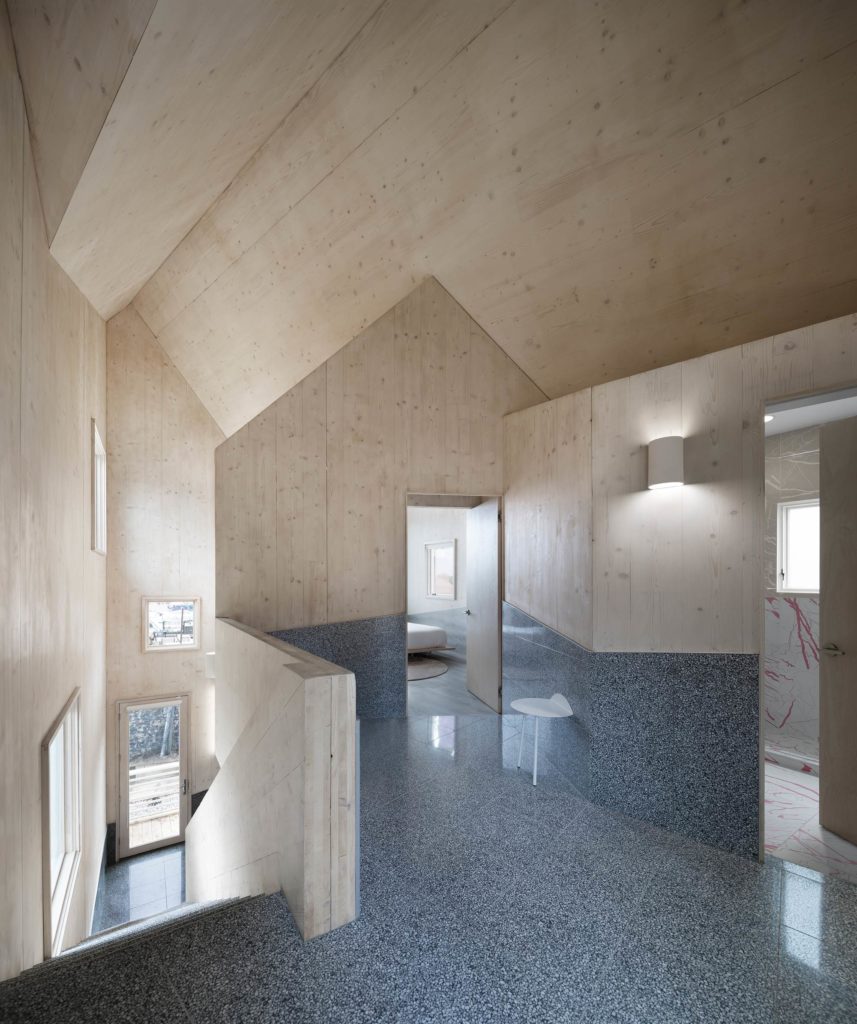
Interior view of Jennifer Bonner’s Haus Gables
With Haus Gables, Bonner questioned the very rudiments of how architects design, and inspired a closer look at CLT’s potential to generate new types or effects. She tackled the CLT challenge alongside project engineer Hanif Kara, professor in practice of architectural technology at the GSD, and a longtime mentor.
While engineering Haus Gables, Bonner and Kara hatched “
Mass Timber and the Scandinavian Effect,” a spring 2020 studio that framed CLT within questions of cultural instigation and identity alongside the material’s physical properties. Bonner and Kara speculated on the possibilities of a so-called “Scandinavian Effect,” fueled by mass timber and the new lenses it offers on material and structural advancement, constructability, and form. They point to parallel currents: the Bilbao Effect—that city’s reinvigoration via a new cultural nexus, the Guggenheim Bilbao—and the Dubai Effect—architectural illustrations of free-market capitalism via gravity-defying skyscrapers.
To test these speculations, Bonner and Kara wanted to apply the Scandinavian Effect to a tabula rasa of sorts—the American South—and see what might stick. “Suddenly the students couldn’t make a purely Scandinavian architecture, but it became something other quite quickly,” Bonner says. Weeks of dialogue and iteration led the studio to speculate on CLT’s potential in new and varied settings. Prompted to design both a house and a mid-rise tower in Raleigh, North Carolina, students experimented with and forecasted where and how CLT may expand its roots.
Tectonic Shifts
Bonner had planned to be on-site for construction of Haus Gables. Instead, a travel snafu grounded her in Cambridge, and left her monitoring a security-camera feed as 11 trailers delivered 87 CLT panels. “The whole thing looked like an architectural model being assembled in place,” Bonner recalls. “If you squint your eyes, watching the panels being installed at that scale, one could imagine: This is the way we cut up materials—chipboard, foam core, and whatever else is on our desks—and make models.” In fact, the house was snapped together much like its
miniature cousin,
The Dollhaus, the intentionally scaled 1:12 model, which Bonner had created as a research iteration through her design practice, MALL.
For the studio, CLT’s diverse characteristics established it as a prime representational canvas for testing architectural possibilities: It can evoke both paper-thin origami and big-block Brutalism; it can be folded and manipulated, but can also withstand extreme weight and pressure; it lends itself to experimentation and play, but begets intense precision and calculation.
The students spent the first few weeks getting to know their new material a bit better. Aryan Khalighy (MArch ’21) began his experimentation with a crude test: he watched empty cardboard boxes fall and stack themselves under simulated gravity, producing a pile of nested mass that appeared like an irregular tower. Similarly, Edgar Rodriguez (MArch ’20)
conceptualized CLT as piled-up mass, from which he realized the opportunity to experiment with the underbelly of the roof. Calvin Boyd (MArch ’21) started the design process for his “Notch House” with a single roof gable, which he then multiplied, creating both added interior space and a central CLT core. Boyd cut treads and slots into that core, generating a stair column that bears the rest of the house’s CLT structure. He describes the effect as one of levitation, illustrating CLT’s ambiguity between heavy and light. (Bonner, too, “started from the roof” with Haus Gables.)
Others identified different tectonic opportunities around which to organize the house. Benson Chien (MArch ’21) looked to the inner-wall spaces that result from traditional “balloon framing”—the use of standard two-by-fours to generate a house’s cubic skeleton. Chien wondered if, instead, layered CLT panels could generate a different wall structure, if not a new typology.
Each of these designers used so-called CLT blanks—structural sheets composed of three-ply, five-ply, and seven-ply CLT panels—as their main ingredient, exploiting the opportunity to play with stacking and layering. Chien’s shotgun-style “McMansion” stacks layers of CLT to form walls, then carves openings in the CLT blanks that serve as both windows and room thresholds. Aesthetically, Chien translated “suburban kitsch” from surrounding homes to the CLT blanks and cutouts of his McMansion, acknowledging the marching spatial rhythm of the shotgun-house typology while metabolizing the house’s surroundings.
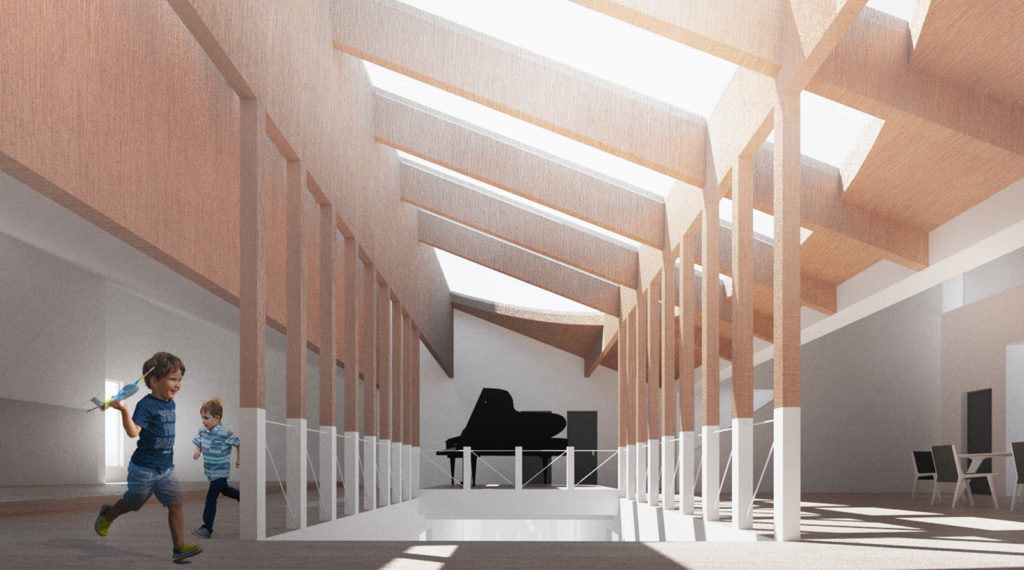
Calvin Boyd’s “Notch House” achieves effects of lightness and levitation via CLT blanks
“On the scale of the panel, one can remove portions of the CLT blank to easily create unique apertures or carve out layers to form custom interior patterns,” observes Ian Grohsgal (MArch ’21). “On the larger scale of multiple panels, one can take advantage of the ready-made quality of CLT to arrange them in unique patterns and to create larger readings.”
Anna Kaertner (MArch ’21) applied CLT blanks to so-called accessory dwelling units—self-contained apartments within an owner-occupied home, either attached to the main dwelling or in a separate structure—interrogating the tendency for the larger house’s structural hierarchy to predominate. Kaertner’s “Big/Little House” centers a staircase that creates a shared skylight for the two houses. She reimagined the roof as beams instead of planes, with interconnecting logs generating a scalloped roof. The resulting curved wall binds the two houses in elevation, generating two sides—one smooth, one serrated—and revealing a new CLT grain through aggregation.
“CLT is an extremely malleable material, and its expression does not need to be planar,” Kaertner says. “Irregular geometry and curves do not produce labor- or materially-intensive processes because the geometries are produced at the same moment and use the same process that produces CLT itself. This makes it possible to seek out these new expressions for connection and structure.”
House design offered an organic testing ground for CLT—after all, wooden houses dot America—but wooden towers remain an anomaly. Despite this, CLT’s ability to bear weight qualifies it as an apt ingredient for the American tower. Anna Goga (MArch ’20)
designed a mid-rise that embraces CLT’s sheer bigness and suggests how the material’s format could generate an entirely new tower typology.
Goga began with simple cuts into CLT blanks, using small pieces of steel at each cut to conjoin pairs of panels. After 400 slices and 400 bandages binding 300 panels, Goga generated an exoskeleton in which the facade line sits
inside the tower. This CLT tube comprises four 24-meter-tall zones with a gantry system of cranes built into each of the four ceilings, allowing for reassembly of floor plates and walls with endless variations. (Here, Kara raises a precedent: Google’s European headquarters in London’s King’s Cross, which offers the largest CLT floor in Europe, a floor that is entirely removable or changeable over the building’s lifespan.)
“We come to an interesting point where a CLT blank encourages us to customize the building three-dimensionally,” Goga says. “I was exploring the idea of the after-life of a building and the possibility to reassemble it from the inside, which is potentially possible with light and easily assemblable CLT panels.”
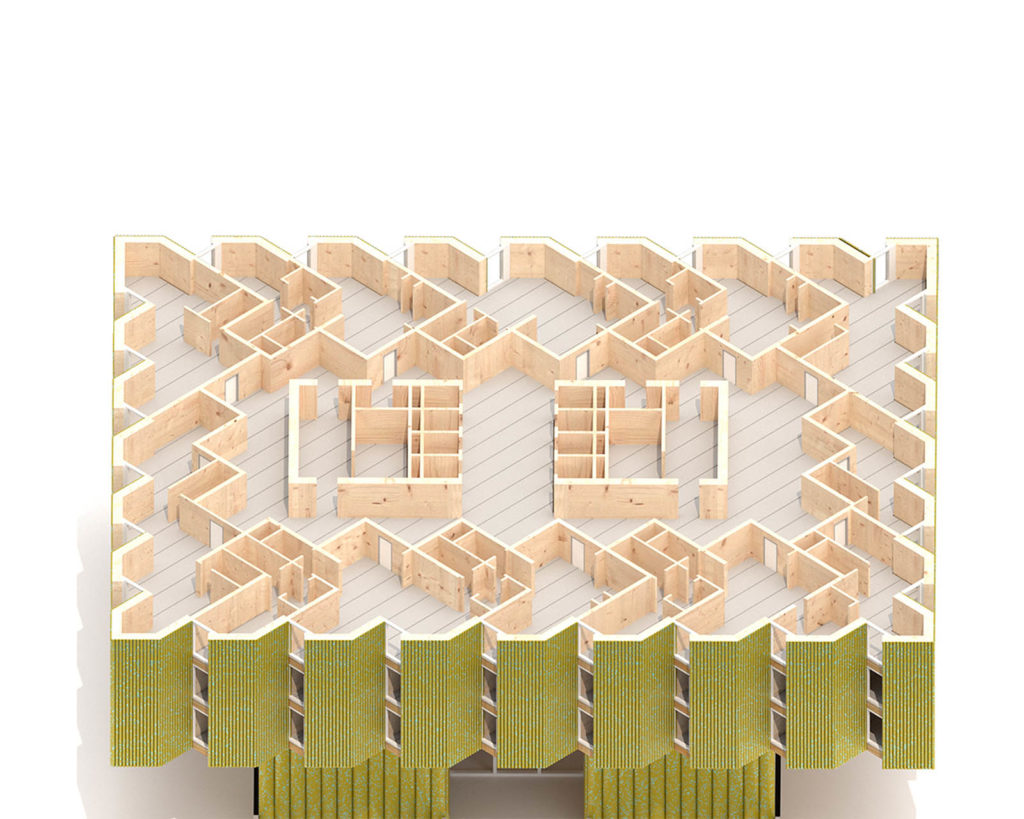
A unit plan of Khalighy’s tower reveals a “sort of mini-suburbia”
As CLT’s tectonics offer the enticement of “scaling up” such reassembly and reconfiguration, designers see grander opportunities for rearrangement or reconsideration of design typologies. Reviewing Khalighy’s CLT tower unit plan, GSD professor
Oana Stănescu noted a “kind of mini-suburbia” emerging—a suggestion of such interplay between CLT tectonics and larger-scale typologies.
Customizably Unexpected
While Khalighy stacked cardboard boxes, Hiroshi Kaneko was carving paper snowflakes. “With early study models, I took advantage of our inclination as architects to use thin, easily workable paper,” says Kaneko (MArch/MDes-HPDM ’21). After leaning paper sheets against each other, he trimmed corners in ways that allowed the paper to retain planarity while introducing subtle, two-dimensional curves, gesturing toward the CNC technology used to machine-cut CLT panels.
“This studio gave us the opportunity to bring to CLT what steel and concrete already benefit from: boundlessness,” Kaneko observes. “The work of this studio, the work of bringing new metaphors into building materials, helps lift the bounds we impose upon materials and opens us up not necessarily to better design but to new technologies that can support our imaginations.” In “Cutting Corners,” Kaneko’s tower proposal, the facade presents what he calls “coherent whimsy” and “allied composition” of patterns, taking advantage of two CLT characteristics: the ability to carve cutouts and textures, as well as the aggregation of wood-grain patterns.
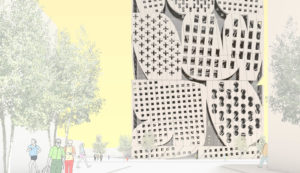
“This studio gave us the opportunity to bring to CLT what steel and concrete already benefit from: boundlessness,” Kaneko observes
Applying digital precision at enormous scales threaded the studio’s speculation; both Goga’s and Kaneko’s exploration of CNC technology, for instance, inspired a broader, more programmatic concept of rearranging entire buildings.
Elif Erez (MArch/MDes-HPDM ’22) traced CLT duality—massive in scale, yet customizable to extreme precision—to its essence: CLT begins its life span as whole wood that is broken into smaller pieces, then stacked and aggregated into CLT form. “I think the CLT blank has a kind of deadpan humor to it,” Erez says. “It is both sheet-like and massive, and when used in the way that one is accustomed to using sheet materials, it does unexpected things with scale and effect.”
In Erez’s house proposal, “
Barn för Barn,” an A-frame volume floats atop three smaller volumes, which in turn form the entryways into three separate housing units, divided by two sets of walls that double up to house bathrooms, kitchen, and storage. As the A-frame volume is raised, the ground floor becomes a shaded outdoor space, offering a collective playground for the three housing units above. Forming three different foundations and entrances, CLT blanks read as simultaneously small and enormous.
Erez scaled-up “Barn för Barn” for her tower proposal, “Barn, Barn, Barn för Barn,” by designing a floating window grid and three cores that support 70 percent of the tower’s vertical load. Erez applied the same system in the house as she did the tower—CLT as shiplap siding—with the effect appearing gigantic on the tower when compared to its traditional use on houses. Each core of the tower offers a component for collective childcare, while main program is pushed to the building’s edges. The tower, with its brushed metal facade, points just a bit off the perpendicular street grid, creating a triangular orientation. The effect is a tower that offers heterogeneous spatial and programmatic possibilities, and a moment in which the domestic and the urban meet and meld.
Kyat Chin (MArch ’21) probed structural opportunities by designing a tower with a rotational wall system instead of a table. Like others, Chin played first with stacking of CLT blanks and spaces; the four generic table types that resulted were then scaled, stacked, and nested in various configurations, achieving column-free plans to accommodate various programs. One effect, Chin says, is illusions of “rooms within rooms.” Chin cladded the tower’s facade with Canadian cedar shingles and anodized aluminum, blending the domestic and the industrial to reinterpret tower aesthetics.
Like Erez, Daniel Garcia (MArch ’20) presented an askew tower—in his words, “slightly misbehaved”—adapting a generic post-and-beam form into what he describes as an exploration of the post-digital at the tower scale. Intended as an art and design school for Raleigh, Garcia’s tower complicates generic form with the sort of hyper-precise digital editing that CLT construction enables. For his house project, Garcia rearranged the Southern “dog trot” typology to suggest a new form: he adapted the dog trot’s main feature—a long breezeway—and split, then offset, the house along that axis, taking advantage of CLT’s distance-spanning properties. He also stamped the house’s asphalt shingles with an embossed image of wood.
Studio colleague Edward Han (MArch ’21) observes that the ability to color-stain, emboss, and cut patterns into CLT means that it can act as a “contemporary kind of ‘wallpaper’ and ornament.” With aesthetics a central studio consideration, this CLT characteristic offered particular excitement. “For the first time,” Han says, “we have a structural material that can be perfectly cut, mitered, shaped, and fenestrated with a CNC machine, offering endless possibilities.”
Instigating Sustainability, and other Perpetual Effects
In testing CLT against images of domesticity and the American South, the studio questioned how CLT’s unique properties might coalesce in creating a new Effect. Cultural readings interlaced studio proposals: suburban kitsch, log-cabin tectonics, “McMansions,” the traditional Southern porch, and American “bigness” found fresh expression. Traditional stick-framing emerged as an unwitting foil.
“Stick-framing relies on repetition of a particular type, producing houses that look the same: repeated American Dreams of previous centuries,” observes Peeraya Suphasidh (MArch ’20), who recently completed “
Wooden House” in Amboise, France. “CLT provides flexibility in terms of customization and gives the ability to do something unique and precise with shorter time.”
One theory behind CLT’s recent recognition has been consumer desire to see more wood. IKEA, for example, structured a 2015 campaign around “wood as lifestyle.” In the studio brief, Bonner and Kara point to IKEA’s Skogsta furniture collection, as well as Sam Jacob’s £30 Plank Scarf, as signaling the image of wood as on-trend. “Wood is often left exposed in mass timber buildings—it doesn’t need to be wrapped or bolstered to meet code—and there is nothing quite so beautiful as large expanses of exposed wood,” writes Vox’s David Roberts. “It is appealing on a primal level, a connection to nature.”
Amid urgent climate concerns, much CLT dialogue circles questions of sustainability. Wood-based buildings can be “carbon sinks,” many argue, absorbing carbon dioxide from the atmosphere. Experts have speculated on the potential to reduce emissions in the building and construction sector (concrete produces
an estimated 5 percent of human-generated carbon dioxide emissions each year). They also expect that it can trim the waste, pollution, and costs associated throughout the construction process—arguing that CLT buildings are simply faster and cleaner to create. And while proponents wrestle with questions about deforestation and supply, Scandinavia has demonstrated that appropriate forestry principles can offset this balance.
The studio also approached broader questions of how, in its application to ongoing issues like housing shortages and
affordability, mass timber like CLT might present disruptive solutions. As such, CLT becomes a tool beyond materiality for the architect, inviting if not begetting a recharged agency for architects and a pull for closer collaboration with engineers, builders, artists, and others. Through such synergy, CLT offers designers the chance to not just design new buildings, but to provoke new typologies and ways of working.
“There is potential here for architects and designers to leverage the digital layer of prefabrication to make real-time decisions on cost, performance, and embodied carbon, among others,” says Lily Huang (MArch ’09), Associate Director of Building Innovations at
Sidewalk Labs. “Taking an iterative approach can create a more robust process, which leads to better buildings. Mass timber has the potential to catalyze an architectural movement that can define how we design and build buildings in the next 50 years.”
“This is the fascinating fact about CLT: it brings structure and architecture—since their divorce in the modern movement—back together,” observes Khalighy. “This is not a compromise on the autonomy of architecture. On the contrary, it expands the agency of architects and enables them to rethink the structural core of architecture through a collaboration with engineers. To have two instructors in our studio—Jennifer Bonner as an architect and Hanif Kara as an engineer—provided a fantastic environment for us to experience the negotiation between both disciplines, not only from a practical standpoint, but as an intellectual activity.”
“Mass Timber and the Scandinavian Effect” was led by Jennifer Bonner, Associate Professor of Architecture, and Hanif Kara, Professor in Practice of Architectural Technology, with Teaching Associate Nelson Byun (MArch ’15). The studio’s February 2020 site visit was generously supported by Sven Tyréns Trust. Dual-Use: Farshid Moussavi on rethinking residential architecture in the wake of Covid-19
Dual-Use: Farshid Moussavi on rethinking residential architecture in the wake of Covid-19
The pandemic has had an immediate and tangible impact upon urban life—rewiring and, in some cases, completely transforming the daily experience of our cities. Nightclubs, concert halls, and stadiums have gathered dust since mid-March, while car-cluttered streets in city centers have transformed into pedestrianized avenues that teem with bistros and eateries. One of the most far-reaching changes has been that in a very short amount of time, our relationship to work has been completely transformed. Millions of people are suddenly working from home, which has raised many questions for the future of housing design.
“Dual-Use,” Farshid Moussavi’s current studio at Harvard’s Graduate School of Design, explores the politics of designing everyday spaces in architecture and the profound impact it has on people’s lives. In an era when residential developments’ cookie-cutter formwork follows private-sector financial systems and reinforces divisions along gender and class lines, Moussavi is interested in subverting that capitalistic demand. By generating new socially inclusive and politically resilient dual-use housing typologies while still satisfying market need, Moussavi adopts an approach that is anchored in real-world problems as well as in the constraints of practice.
According to Moussavi, over the course of the pandemic, we have inadvertently traveled back through time: reverting to a preindustrial, 19th-century housing model, wherein domestic space was also the workplace. Today, office workers roll out of bed, don their work shirts, and find a flattering corner of their home to load up Zoom. A craftworker folds out a workbench from a closet in his studio apartment, while a mother feeds her baby before heading into a spare bedroom that has been repurposed as a hair salon where she receives clients. But working from home is far from a universal right; the pandemic has revealed and intensified inequalities of privilege, labor, and class as not all work can be accommodated in the standard modern apartment.
Moussavi explains that even as the pandemic has pushed to the surface the inequality embedded in the current DIY conversion of domestic space into workspace, it has also presented the idea that another world might be possible. If we abandon the live-work binary that has dictated the development of modern cities, how might new urban residential typologies be enriched with equality, diversity, and resilience and generate new forms of social capital within a truly shared experience of city life? It is an exciting and vital time.
“Generally, left-wing activists, academics, and journalists blame the housing crisis on neoliberal enterprise and the nation-state for abandoning welfare,” says Moussavi. “We need to understand the housing crisis as a typological question too—not just who delivers housing, but how it’s designed, and what can be done differently as well.”
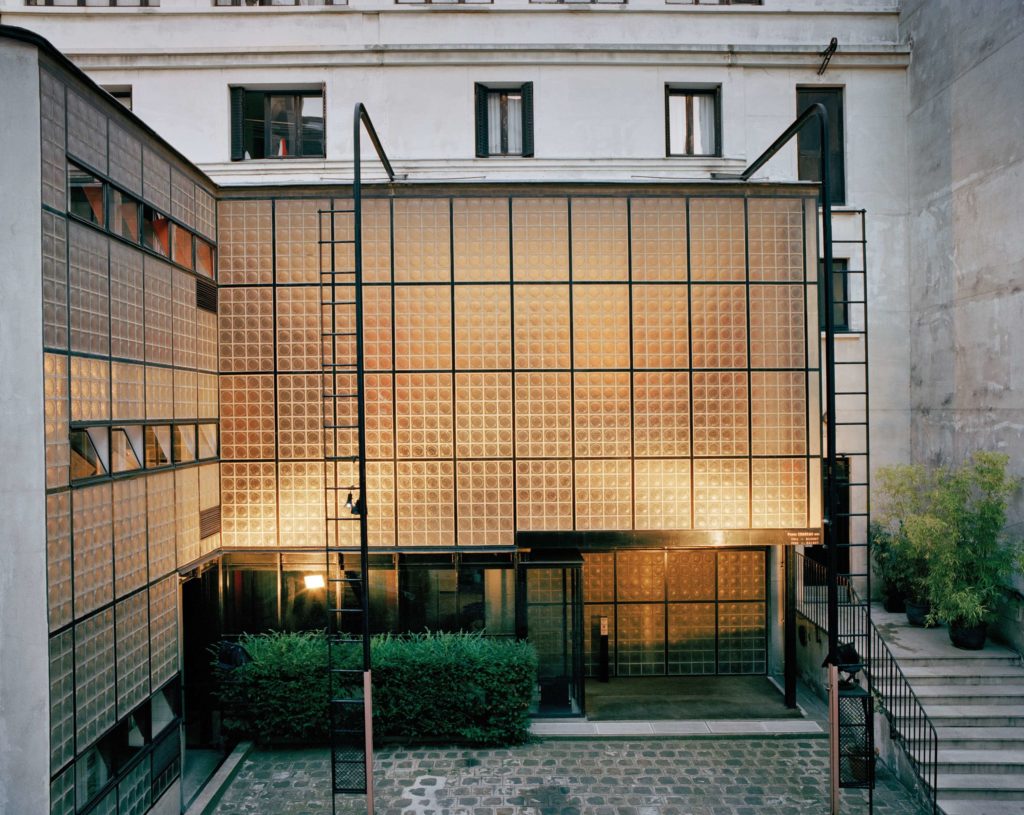
Maison de Verre, Photography: François Halard
Grounding the recent attention placed on dual-use residential architecture within the much longer history of live-work domestic spaces, this studio merges an in-depth historical survey with emerging contemporary criticism. A book identifying eight types of workers that must be taken into account with any dual-use architecture, penned by
Frances Holliss, London-based architect and emeritus reader in Architecture at London Metropolitan University, will be discussed in tandem with case studies ranging from the medieval English house where farmers lived alongside their livestock to recent examples. The Mumeisha Machine in Tokyo, built in 1909, for example, features a long corridor that acts as a transition space between the public street and private residences around back, while the Maison de Verre in Paris, built in 1932, features a three-doorbell system in a doctor’s home office, with separate entrances, so that professional and personal affairs could be carried out in their own designated space.
The studio will also conduct virtual home visits with individuals representing these different home-work setups. And it will hear from architects and historians of architecture and art including
Umberto Napolitano,
Irénée Scalbert, and
Hans Ulrich Obrist on the relationship between housing and spatial diversity, biodiversity, and user-empowerment.
Building upon a sequence of housing studios Moussavi has taught since 2017, “Dual-Use” brings an additional protagonist—
Yona Friedman—to join two French architects researched by the previous studios. The 19th-century Parisian Georges-Eugène Haussmann’s flexible block system, which was investigated in the 2017 studio, is in many ways the antithesis of Jean Renaudie’s spatially complex 20th-century residential architecture, which was investigated in the subsequent studio. In different ways, Haussmann and Renaudie sought to interconnect the design of individual dwellings and the urban space, and focused on user empowerment through the provision of spatial diversity. Yona Friedman offers an interesting comparison point, with a largely theoretical practice that was centered on ideas of self-planning and user-appropriation of space.
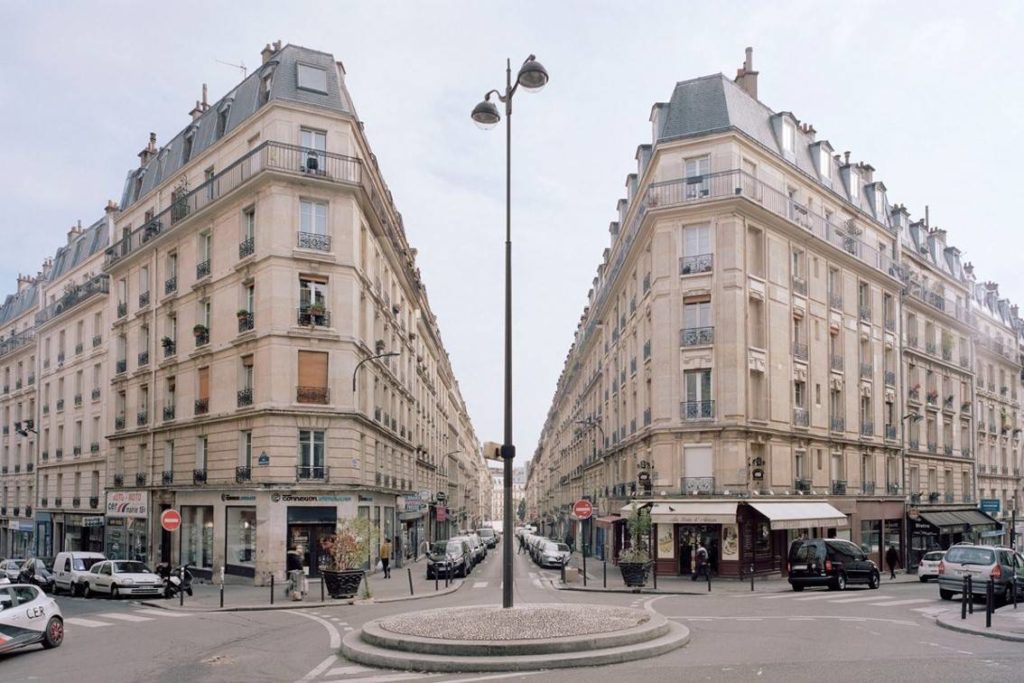
Haussmann’s Rue Eugène Sue in Paris. Photograph: Cyrille Weiner.
According to Moussavi, in Haussmann’s system, external consistency is king—long blocks of housing carve out the shape of the city, while the internal elements remain flexible and readily tailored for individual use. A tall lower level with ample natural light provides the perfect site for unique live-work configurations, while the block retains a uniform urban facade. Renaudie, meanwhile, takes the opposite approach in his kaleidoscopic Ivry-sur-Seine, which offers spatially unique dwellings, no two of which are identical. Garden-scale balconies spill out beyond the apartments and provide a strong connection between domestic space and the landscape, between biodiversity and well-being. Malleable space, a flexible boundary between intimacy and community, and multiple types of use are built into Renaudie’s architecture. Friedman, a contemporary of Renaudie, was largely a theorist; projects like the Flatwriter—which could ostensibly help users design their perfect apartment with the press of a button—are far more utopian, untethered to market demand.
“Haussmann begins from the collective, whereas Renaudie departs from the individual—and with a focus on biodiversity in cities, is very relevant to our concerns today,” says Moussavi. “Friedman adds that element of ambiguity. You can learn from all three of them simultaneously and find new applications for their work in the conditions of the present—that’s the beauty of having history behind you, and why I’m a huge fan of precedents.”
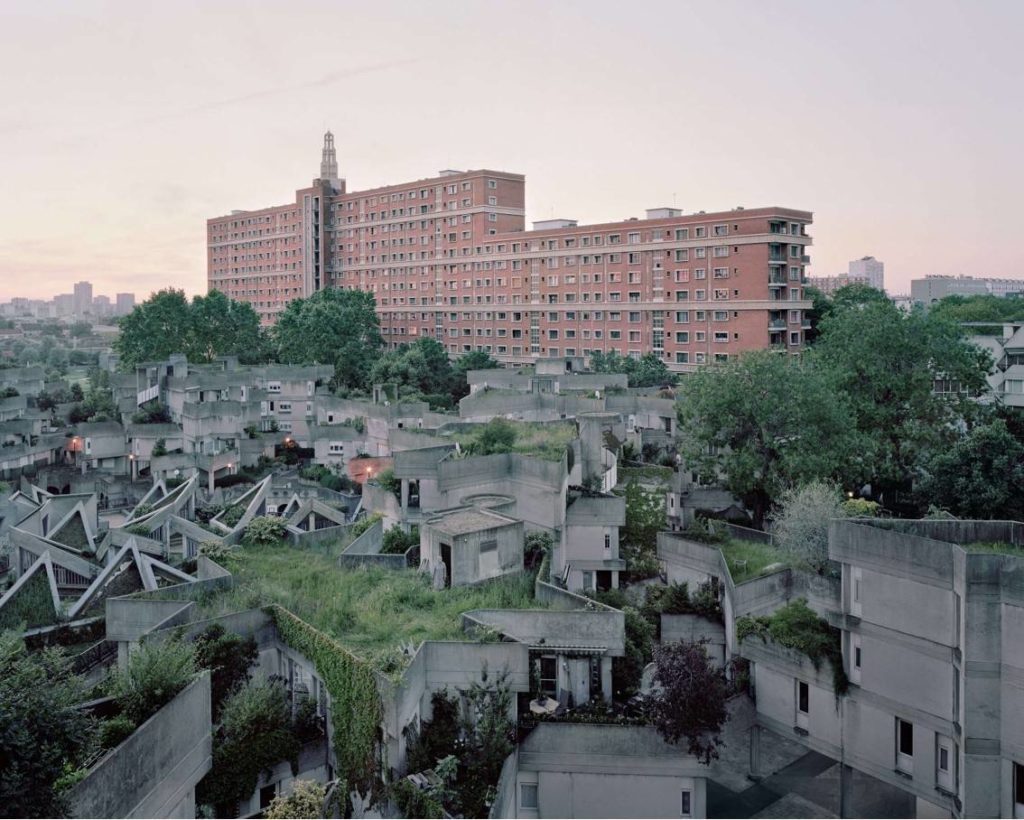
Renaudie & Gailhoustet (1969), Cité du Parc, Ivry-sur-Seine, France. Photograph: Laurent Kronental
Students will apply their insights to these architects’ work in designing their own dual-use block in one of three sites along La Petite Ceinture—meaning “the little belt” in French—a 32-kilometer stretch of unbuilt land surrounding Paris. Containing the skeletal remains of a 19th-century railway system, the belt has become a space of wild abandon. Known as the mecca of Parisian street art, it also includes areas of slums and overgrown nature. Data from public consultations gathered by
Paris Urban Agency (APUR) shows the belt’s latent potential in the city’s collective conscience: community gardens, affordable housing, and a wildlife reserve were among the suggestions raised by the public.
Based in the 16th, 13th, and 19th arrondissements, these sites vary widely in their own topographies, demographics, and the way they slot into Parisian life and culture. Moussavi explains that the 16th, known as the rich urbanites’ enclave, has the least social housing of anywhere in the capital, while the 19th—the poorest arrondissement in Paris—has the highest concentration of social housing and is the site of former refugee camps. All of the sites are elevated above or face the material ghosts of the railway. Surrounded by Haussmann blocks, parking lots, abandoned stations, and jazz clubs, these are loaded spaces, and the students will need to be surgically precise in their interventions. The future of Paris is waiting.
“We are asking the students to take a visionary position,” says Moussavi. “The pandemic has called into question the efficiency of all the old housing systems, and I think it’s up to us to produce the visions of tomorrow.” The need for alternative typologies for live-work housing is self-evident. According to a study published by the Stanford Institute for Economic Policy Research this summer, 42 percent of the US labor force is currently working full-time from home; this figure climbs to 52 percent in Europe, and 65 percent in the UK. Even when a vaccine is made widely available and we flatten the COVID curve for good, many Fortune 500 companies will continue to allow employees to work from home. The studio is an opportunity to rethink residential architecture and generate new typologies with dual-use apartments that are suited for a variety of households and that place individuals as well as community at their core.
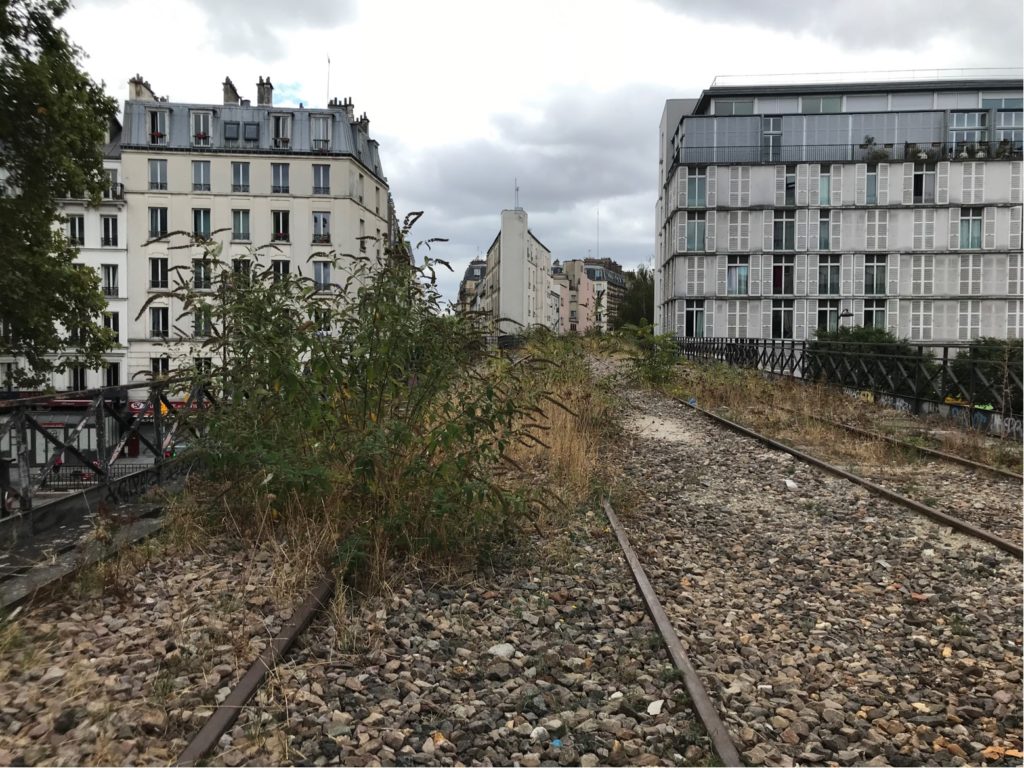
Petite Ceinture, Pont de Flandres Station, Site C. Photograph: Guillaume Choplain.
As seen in the organic evolution of Renaudie’s private terraces into community gardens at the hands of its residents, it’s important for these new typologies to be adaptable: both toward their inhabitants’ fluctuating needs and for unseen future circumstances. In its capacity to incite structural change and transgress the current boundaries of architectural thinking, the pandemic is a catalyst to cross that threshold—but it shouldn’t be understood as an isolated scenario. “Architecture must not be just reactionary,” cautions Moussavi. “Genuinely equitable dual-use domestic space is not just a pandemic issue, but a matter of one’s right to a supportive live-work environment regardless of profession.” This right, and its future rewards of resilient, enlivened communities, persists far beyond the confines of any pandemic.
Hidden Territories: Uncovering the racist legacy of the American landscape
Hidden Territories: Uncovering the racist legacy of the American landscape
The term “landscape” historically referred to pictures of the world—vistas or views—and so it is only a small step to think of landscapes as portraits of society, representations of social imaginaries. What is included and excluded in these pictures is revealing. A landscape can be a tool for a designer: a mirror held up to society that exposes the distortions and repressions that underpin its self-image. In the past months and years, activists have aimed to hold up such a mirror to reveal systemic racism in America. Students, faculty, staff, and guests at the GSD have joined in and sometimes led the way. I have had the opportunity to interview several of these inspiring figures:
Everett Fly,
Jill Desimini,
Linda Shi,
David Moreno Mateos, and
Kathryn Yusoff. Their viewpoints vary, but all agree that adjustments to the disciplines taught at the GSD would help in coming to terms with—and hopefully undoing—the systemic racism revealed across the American landscape.
The architect, landscape architect, and preservationist Everett Fly notes that this process begins with seeing. Fly grew up and now practices in San Antonio, Texas, a city with a palpable sense of heritage embodied in its historic architecture. San Antonio formed Fly’s sensibility, which he hopes more designers will share. “Too often, architects start with their plan by assuming that no other culture has influenced or impacted the site where they’re planning. . . . [They assume a] clean slate—as if no one had ever existed there.” But contrary examples make their way periodically into the news. In 2010 in
Sugar Land, Texas, excavations for a public building project uncovered a mass gravesite containing the remains of 95 former slaves. Similar discoveries occurred in New York and Philadelphia. Important stories had been buried along with these bodies. “For too long we have lived with the assumption that there is nothing significant you need to know about African American history in the landscape,” Fly says.
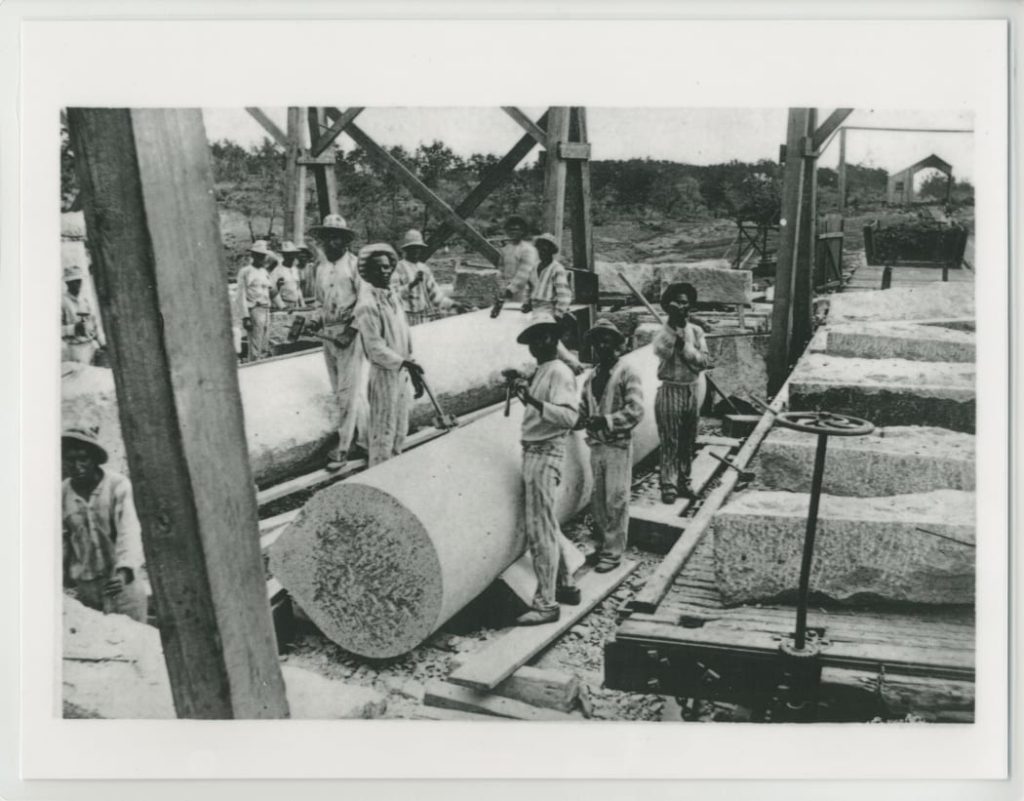
“Prisoners working construction, Convict Leasing Photograph 8.” Couresy: Woodson Research Center: Rice University.
Fly first came to this realization during his education as an architect. Like today, the 1970s was a period of strong social justice movements. At architecture school in Austin, Fly had few Black classmates, and he never heard professors speak about the contributions of African Americans to American architecture. When he began graduate studies at the GSD, Fly enrolled in a history course taught by J. B. Jackson, who was transforming the field of cultural landscape studies. Jackson talked about the role of Indigenous peoples and European immigrants, as well as the impact of railroads and highways within the American landscape. It was far from the clichéd notions of landscapes as merely picturesque views. Still, Jackson only mentioned African Americans a few times. With a streak of defiance, Fly set out to write a term paper on historic Black towns in the South.
By the end of a semester of intense archival work, he had amassed a few dozen brief references. Jackson took a personal interest in the project, which Fly continued into the following semester. He soon included examples scattered across the United States. Fly began sharing his findings at conferences and making contacts in historic preservation. After graduating, a year-long fellowship allowed him to visit many of these towns and go to the cartographic division of the National Archives to seek out obscure maps. “This opened up another vision for me: that you could document these places, despite what people would say, that ‘we don’t have the information’ or ‘you can’t prove that these existed,’” Fly explains. What followed has been a lifelong practice of gently asking people to look again. When greeted with “No, we don’t have anything like that,” he replies: “I bet you do, and you just don’t know how to look for it.”
Fly’s work as a preservationist came together as three components: “Being able to see the communities, being able to find the documentation, and then being able to correlate that with the formal discipline of historic preservation.” This work is as important now as ever. Take cemeteries. Because of discrimination, African Americans were often turned away from public cemeteries, and burials had to take place on private land at some distance from where people lived. These small private cemeteries—”some of our most treasured and valuable sacred places”—are threatened by their obscurity. The first step is to know they exist, then to document them, and finally to engage the mechanisms of historic preservation. Similar to graveyards, early structures such as schoolhouses and churches were built by African American tradespeople rather than architects because pathways to licensure were not available. Seeing and valuing them means also valorizing a thread of African American cultural heritage. “We’re not just protecting the physical structure,” Fly says, “we’re also protecting the legacy of the trades.”
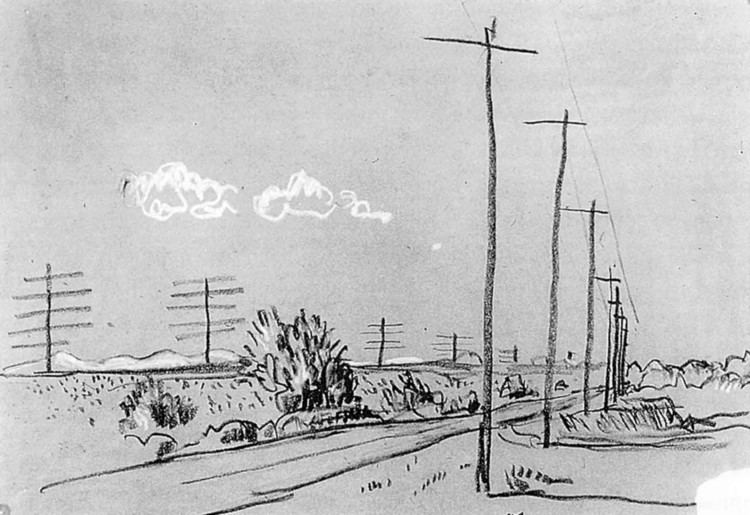
Sketch by JB Jackson
Fly urges more young designers to take an interest in the forgotten cultural heritage that can be revealed across the American landscape. He says that this work begins by always asking the client a question: “How much research have you done ‘below the surface,’ into the layers of history—who lived on this place before today, and how did they live here?” In Fly’s experience, a client will often say that they haven’t done any research. That leaves it up to designers to uncover traces that can be used to “enhance the richness of your design, and help educate your client and the users of the site.” Drawing out more layers adds richness to the picture a landscape presents.
Sometimes whole other types of sites become visible when a landscape is critically reexamined. Jill Desimini, an associate professor of Landscape Architecture at the GSD, is a champion of vacant lots. Although they are relatively rare in the centers of growing cities, in parts of other cities—Detroit, for example—vacant lots predominate. Desimini emphasizes that this is not a neutral result of market forces, but a dynamic that plays out in countless decisions that are often biased in unacknowledged ways by race and the perceived value of land. “You see aggregations of vacant land in places where residents are people of color, where people are impoverished, where toxicity levels are high due to past decisions, where predatory lending prevails, and where there is a lack of access to resources and services,” she says.
Cities prefer the easy solution of selling land to generate tax revenue. Desimini suggests exploring pathways for “returning land to the neighborhood.” This is not as simple as it sounds—it is a process that must be envisioned and designed. Desimini is currently teaching “From Fallow: Equitable Futures for Landscapes of Injustice,” a seminar at GSD that “partners with a few progressive organizations that care for vacant property.” She says that the open-ended nature of studio research is an asset: “It is a matter not so much of making drastic change to the sites themselves, as drastically reimagining how we approach them.”
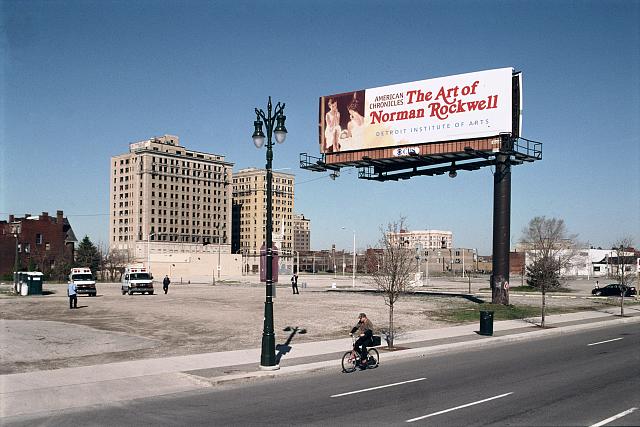
Vergara, Camilo J., American Chronicles sign, view NW from Woodward Ave. at Sibley, Detroit, 2009.
, Desimini’s larger project involves changing the way landscape architects work. Her books,
Cartographic Grounds: Projecting the Landscape Imaginary (with Charles Waldheim) and
From Fallow: 100 Ideas for Abandoned Urban Landscapes, are both invaluable resources. Investigation, drawing out possibilities, publishing, and conversation can have a dramatic impact on the course of a discipline. She explains, “I think that we need to be less fickle and faddish and work on projects for a long time and in places for a long time. It is hard to sustain the interest, but I think that it is necessary to build trust.” To undo systemic injustices in the American landscape, a sustained systemic response is necessary.
Linda Shi,
an assistant professor at Cornell’s department of City and Regional Planning, has come to a similar conclusion but from a different direction. As an expert on urban environmental governance, Shi examines and suggests planning policies for addressing climate change while simultaneously improving social equity. Her studies are capacious, with titles such as
“Explaining Progress in Climate Adaptation Planning across 156 U.S. Municipalities.” But they are rooted in careful investigations of local policies—for example, a series of resilience action plans for Boston.
Shi’s focus on policies is unfamiliar to most designers: “In planning, the things we often trade in are papers and books” rather than in projects and precedents. Landscapes are shaped by policies, but planning and design “often happen in the absence of a consideration of policy and other realities that constrain action,” she says. Imagine, for example, a project to build a new park in a low-income neighborhood. It seems good—an amenity for the community. But if a parcel of land becomes a park, it will not be generating property taxes. And who will use the amenity? If designs do not account for policy structures, the market will take over and “do what it does, which is gentrify.” The park may ultimately exacerbate inequities by driving up housing costs. Shi suggests applying the design imaginary to the policy sphere: “a combination of policy and design, rather than the two being separate.”
She began working on issues of equity and justice from a background in environmental management. While working for
AECOM,
Cambridge-based I2UD, and elsewhere, she realized that, in practice, environmental governance is “all about social issues and the rural-urban relationship.” Shi enrolled in a planning doctoral program and was particularly moved by
class taught by Neil Brenner and Diane Davis that gave her a theoretical lens on what was happening and her role in it. She finds this perspective crucial: “Planners, as much as architects, need more reflexive thinking about our roles in our projects and how we embed a concern for justice in our work.”
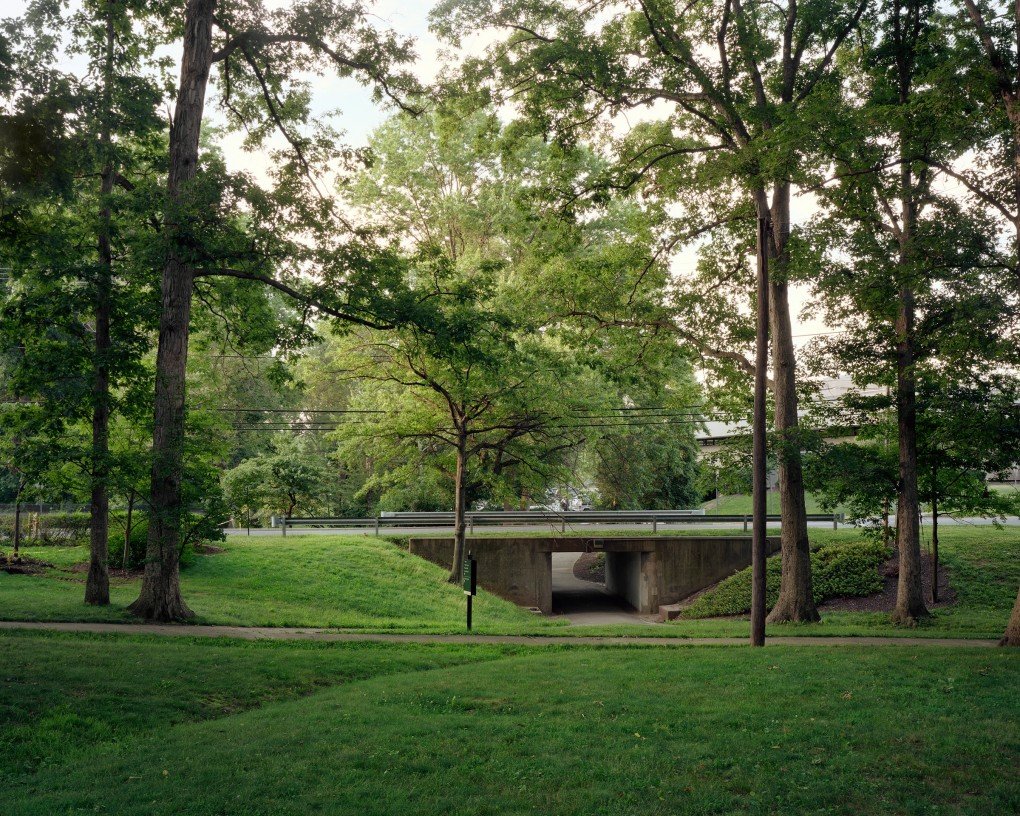
Greenbelt, Maryland, was planned and built by the Resettlement Administration under Rexford Guy Tugwell during the New Deal. [Jason Reblando, from New Deal Utopias]
When asked what planners and designers should do, she warns that devolving decision-making to the community level is not enough.
Community organizations have elevated the importance of justice, but injustices emanate from policy structures that need to be addressed at regional, state, and federal levels. Intent is most important, she says, and “a major issue with the design disciplines is that they don’t teach social justice.” She points to
Billy Fleming’s article in Places, “Design and the Green New Deal,” calling for a role for public landscape architects as one possible direction of reform. But there is no simple fix. For systemic change, Shi says, “We have to transform all of these disciplines.”
One path for change may come from outside the core disciplines of the GSD. David Moreno Mateos, an assistant professor of Landscape Architecture at the GSD, is a restoration ecologist—which is to say, he is a scientist. Moreno Mateos teaches
“Ecosystem Restoration,” “Climate by Design,” and, this semester,
“Re-Wilding Harvard.” This most recent seminar stems from a radical proposal to return Harvard’s landscape to a condition of wilderness. For now, Harvard has only offered a small plot for experimentation, but what is important for the seminar is not the scale, but the vision. Imagining landscapes without humans is a useful thought experiment for designers who ought to be able to justify the human control their projects require. Moreno Mateos has worked on much larger sites that have been severely degraded by human activity, including Southwest Greenland, where Norse sites have been recovering for more than 650 years. For the Harvard site, Moreno Mateos notes that “Lawn, from a biodiversity perspective, is green cement.” A wild landscape is one that can function on its own, and it is a bold claim that functional wilderness can be re-created even in the middle of Cambridge.
According to Moreno Mateos, part of the process of re-wilding Harvard is to “learn from how people were using the land before European settlement.” Different human groups have had differing power to transform landscapes. The Indigenous peoples of North America had their own impact, causing 95 percent of megafauna on the continent to go extinct over a period of thousands of years. European colonists caused fewer extinctions, but their impact was larger and more temporally concentrated. Human-caused ecological changes are ongoing: with vastly fewer buffalo, for example, forests are now expanding into the Great Plains. The idea is not to assign blame or to return to an imagined idyllic state, Moreno Mateos says, but to see that as one culture displaces another, ways of viewing the land also shift. Now more than ever “we have entirely domesticated landscapes that are not real.”
Moreno Mateos’s work suggests a certain type of environmental justice: “the right of species to live in the place where they used to be.” The first step, he says, is to “understand what an ecosystem actually is,” how it operates, how it responds to human impact, and how it can recover from them. From there, landscape architects may be in positions to use design to help these processes to happen, working with clients on specific sites. And even with wilderness, human involvement is crucial: “You need to listen to people. You need the people who live with an ecosystem to be part of it. Otherwise it’s going to fail,” he explains.
Of all those I interviewed, Kathryn Yusoff offers perhaps the widest lens in generating a picture of the interrelationship of race and landscape. Yusoff holds the unusual title of
Professor of Inhuman Geography at Queen Mary University of London. The cases she brings to the table defy reduction. She gives me an example: “Convict-lease prisons in Alabama were built at the entrance to mines. These prisons were filled with Black men and boys that were literally kidnapped from social space to enter a legal system that systemically punished Blackness, while simultaneously co-opting Black life to corporations as a ‘resource’ for industrialization. Convicts were sent to mine coal and work in the iron ore furnaces. So, there is a very clear connection between what goes up, in terms of the buildings of modernity in the ‘Magic City’ of Birmingham, Alabama and the shares in northern stock exchanges, and who goes down into the underground. This landscape of racial capitalism both met the political ambitions of white supremacy by suppressing the Black vote and materially built the post-plantation urban landscapes through another form of Black subjugation.”
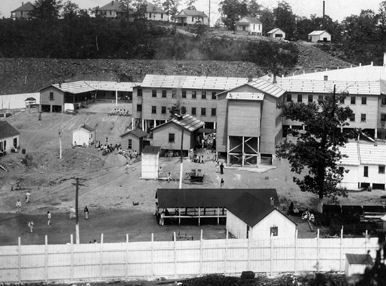
Pratt Company Mining Prison Camp, Alabama (Mining Artifacts).
How to untangle this complex nexus and engage with it as designers? For Yusoff, the first step is to shift what is taken as the object of design. “There is a tendency to assume that the built environment is the primary space of consideration, whereas I would like to disassemble that ‘autonomy’ and have us think with a broader set of relations of the un-architectural or what might be called the subterranean architectures of spatial practices.” If buildings and landscapes present flattering pictures of a simple and tidy social order, a little excavation will uncover a vast network of lives that have been repressed. “What are the racial undergrounds that enable the verticality of the city, its flows, and material connectivity?” she asks.
Yusoff’s work upends key concepts that are in danger of becoming platitudes. In response to the vogue for the Anthropocene (a term that refers to the current geological period, in which humans are having a definite geological impact), Yusoff demands “a billion Black anthropocenes, or none.” The life and perspective of each Black body that has made “the Anthropocene” happen must not be forgotten under the rubric of such a wide and abstract term. “These are the billion life-worlds of Indigenous and Black peoples that colonialism attempted but failed to extinguish,” she says.
Yusoff’s project is big, and its implications are daunting. “This is a transnational and planetary affair and involves confrontations with the histories of settler colonialism, neo-extractivism, and the normative understandings of matter itself.” For designers, aesthetics—how things look—may be the most accessible aspect of Yusoff’s work. She recasts aesthetics as political: “Political aesthetics is a way to think through the aesthetic-as-always-implicated in the construction of sense and sensibility, which is more than a question of feeling. I think about these arrangements of sense as a ‘affectual architectures’” Telling a story, painting a picture, or constructing a landscape is a political act. “We can see any mapping of planetary origins as a world-building praxis, where people and places get framed in certain ways.” One task for social justice, then, is to pay attention to the “strata of peoples that underpin planetary transformation and are pressed closer to its harms.”
However landscapes are understood, seeking justice within them cannot be a simple affair. Engaging with a functioning ecosystem within a cultural landscape and within a democratic society should be viewed as an ongoing process. This engagement involves actively studying—and imagining—what landscapes are, and what they can be. Only then can we begin projecting a better world onto them.
With student advocates’ help, Cambridge set to build more affordable housing
With student advocates’ help, Cambridge set to build more affordable housing
Last month, the city council in Cambridge, Massachusetts, voted to smooth the path for more affordable housing to be built in the city, from which people on low and average incomes are increasingly being squeezed out. The news follows a campaign of more than a year in which students from Harvard’s Graduate School of Design advocated in favor of the “affordable housing overlay.”
Patrick Braga (MUP ’20), who was awarded the
2020 Ferdinand Colloredo-Mansfeld Prize for Superior Achievement in Real Estate Studies in part for his work on the campaign alongside the nonprofit group
A Better Cambridge, says that students had a vital role to play because they are intrinsically tied into the local housing economy. “There will always be students in Cambridge and many of them are taking up apartments that could be going to local people,” says Braga. “If we can get affordable housing built that’s directly geared toward local people, there will be a little less competition at that tier of the housing market.”
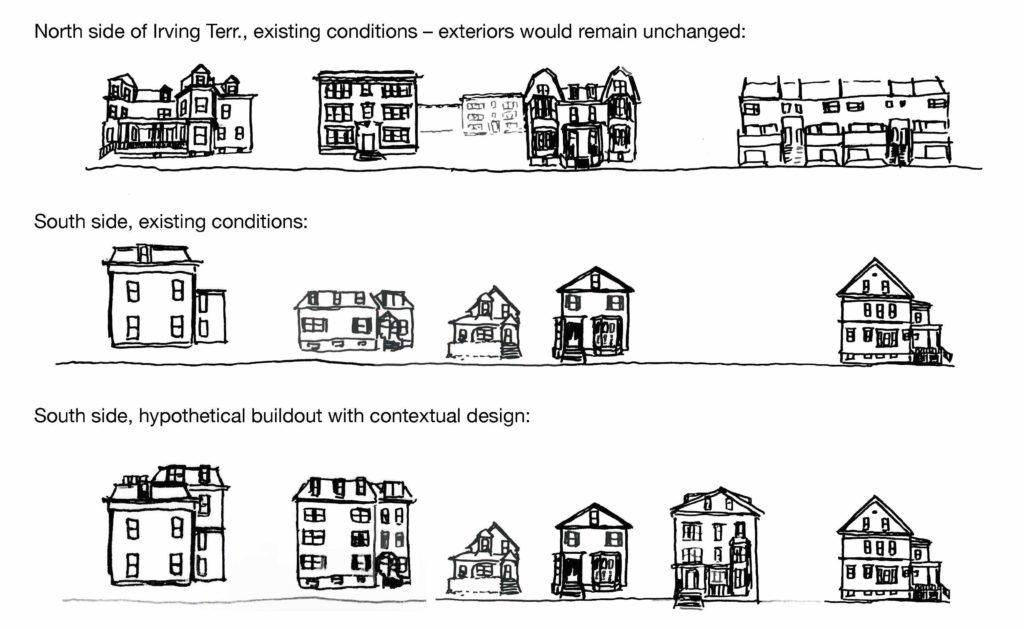
Drawings illustrating the potential and benign impact of the Overlay on Irving Terrace, which happens to be located next to Gund Hall. (Courtesy of Patrick Braga)
The overlay was passed into law by seven of the nine city council members. It means that new developments or conversions in which all units are reserved for households earning below the local median income—at no more than 30% of their earnings—will be automatically allowed, without the need for additional permits.
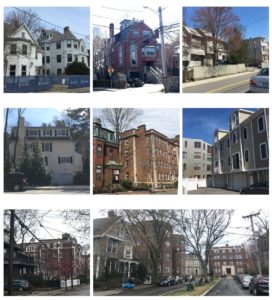
Examples of four-story buildings already found throughout Cambridge. (Courtesy Patrick Braga.)
As a result, affordable-housing developers will be better placed to compete with private real-estate companies. Previously, the high cost of land and construction and complex rules about the nature of new architecture made it difficult to build anything that would not make a profit. Developers of affordable homes may now find it easier to secure public funding for their proposals, since the release of subsidies often requires them to prove they meet, or have approval to deviate from, zoning requirements. “For developers of affordable housing, having this kind of predictability streamlines the construction process tremendously,” Braga says.
In 2019, 14.8 percent of Cambridge’s housing stock was estimated to be affordable. The hope is that the overlay will allow this number to increase to 16 percent by 2030—a vital increase in a majority renter city. Getting the law passed wasn’t straightforward, Braga says, who worked alongside other GSD students including Thandi Nyambose (MUP ’21), Henna Mahmood (MUP ’21), and Suryani Dewa Ayu (AB ’15 MUP ’20) on the effort. There were concerns from residents that giving the green light to any development that met the basic zoning requirements would mean a flurry of new buildings that clashed with what they saw as the original character of the city—defined by the elegant four- to six-story buildings that were permitted under the height constraints of the 1920s.
“By the 1950s, Cambridge actually had no height limit to its buildings, and there was a lot of a backlash against the architectural changes and the large buildings that suddenly felt out of place with the more human-scale neighborhoods that residents were used to,” Braga explains. “And in the 1970s and 1980s there was increasing recognition of the importance of giving residents of cities and neighborhoods a voice in what future development should look like.”
I think a strength of the GSD is that it made clear to me how important illustrations and visuals are for a policy proposal like this.
Patrick Braga (MUP ’20)
Since then, development in Cambridge has required a lot of negotiation to deviate from zoning codes. “It could take upwards of a year, which meant affordable-housing developers were facing a tremendously high barrier of entry,” Braga says. “Meanwhile, the economy of the Greater Boston region has been booming and jobs are being added faster than housing units, leading to long-time residents and people like firefighters and teachers having increasing difficulty finding homes.”
Last summer, residents and city officials debated the new policy in a meeting that lasted five hours. Passing it meant persuading city council members and reluctant residents, particularly longtime homeowners, that the new rules would not disrupt their neighborhoods. “A lot of people were founding their fears on the notions that there would be high-rises everywhere and old buildings would be demolished, and that their sense of stability would be upturned,” Braga says. “I think a strength of the GSD is that it made clear to me how important illustrations and visuals are for a policy proposal like this.”
As part of the process, the city commissioned a local urban designer to make 3D models to demonstrate that the scale of new buildings would match what already existed. And Braga proposed a rule for how to calculate minimum front setbacks for buildings—by referring to the existing structures on either side—an idea that was eventually incorporated into the final ordinance.
Both a recent graduate and a Cambridge native, advocate Dewa Ayu brings a unique perspective: “As someone who was raised in Cambridge—a proud daughter of street vendors and small business owners—I am excited to see how this can lead to centering the most marginalized voices in our city,” she says.
Excerpt: Cities in Imagination, by David Maddox
Excerpt: Cities in Imagination, by David Maddox
“Five years ago, the Harvard Graduate School of Design’s
Just City Lab published
The Just City Essays: 26 Visions of Inclusion, Equity and Opportunity. The questions it posed were deceptively simple: What would a just city look like? And what could be the strategies to get there? These questions were posed to mayors, architects, artists, philanthropists, educators and journalists in 22 cities, who told stories of global injustice and their dreams for reparative and restorative justice in the city.

These essays were meant as a provocation, a call to action. Now, during these times of dissonance, unrest, and uncertainty, their contents have become ever more important. For the next 26 weeks [starting June 15, 2020], the GSD and the Just City Lab will republish one essay a week here and at
designforthejustcity.org. We hope they may continue conversations of our shared responsibility for the just city.
We believe design can repair injustice. We believe design must restore justice, especially that produced by its own hand. We believe in justice for Black Americans. We believe in justice for all marginalized people. We believe in a Just City.”
—Toni L. Griffin, Professor in Practice of Urban Planning, founder of the Just City Lab, and editor of The Just City Essays
Cities in Imagination
By David Maddox
Resilience is the word of the decade, as sustainability was in previous decades. No doubt, our view of the kind and quality of cities we as societies want to build will continue to evolve and inspire new descriptive goals. Surely we have not lost our desire for sustainable cities, with ecological footprints we can afford, even though our focus has been on resilience, after what seems like a relentless drum beat of natural disasters around the world. The search for terms begs the question: what are the cities we want to create in the future? What is their nature? What are the cities in which we want to live? Certainly these cities are sustainable, since we want our cities to balance consumption and resources so that they can last into the future. Certainly they are resilient, so our cities are still in existence after the next 100-year storm, now due every few years. And yet…as we build this vision we know that cities must also be livable. Indeed, we must view livability as a third indispensable leg supporting the cities of our dreams: resilient + sustainable + livable.
But we have to hope that justice hasn’t gone out of style. Because while resilience is the word of the decade, we’ve struggled with just cities for a much longer time. Largely we have come up short.
So this imagining needs a fourth leg. These are the cities of our dreams: resilient, sustainable, livable, just.
Let’s imagine.
We can imagine sustainable cities—ones that can persist in energy, food and ecological balance—that are nevertheless brittle, socially or infrastructurally, to shocks and major perturbations. That is, they are not resilient. Such cities are not truly sustainable, of course—because they will be crushed by major perturbations they’re not in it for the long term—but their lack of sustainability is for reasons beyond the usually definitions of energy and food systems. We can imagine resilient cities—especially cities that are made so through extraordinary and expensive works of grey infrastructure—that are not sustainable from the point of view of energy consumption, food security, economy, or other resources.
We can imagine livable cities that are neither resilient nor sustainable.
And, it is easy to imagine resilient and sustainable cities that are not livable—and so are not truly sustainable.
Easiest of all is to imagine cities of injustice, because they exist all around us. The nature of their injustice may be difficult to solve or even comprehend within our systems of economy and government, but it’s easy to see.
The point is that we must conceive and build our urban areas based on a vision of the future that creates cities that are resilient + sustainable + livable + just. No one of these is sufficient for our dream cities of the future. Yet we often pursue these four elements on independent tracks, with separate government agencies pursuing one or another and NGOs and community organizations devoted to a single track. Of course, many cities around the world don’t really have the resources to make progress in any of the four. Continue reading on designforthejustcity.org…
Will urban life recover when the pandemic is finally over? Alex Krieger on the fate of the American city after Covid
Will urban life recover when the pandemic is finally over? Alex Krieger on the fate of the American city after Covid
Yes, the pandemic (somewhat understandably) and the protests for justice (sadly) are leading to a partial withdrawal from our cities. Of course, such departures have occurred a number of times over the course of American history. Americans have not needed much encouragement to seek a bit of space between themselves and the “rasping frictions” of big city life.
Prior to the pandemic, American cities were on a roll. Since the turn of the millennium at least, America was actually witnessing an urban revival. Suburbia had lost much of its appeal for the generations that grew up in it, and memories of mid-century urban decay had largely faded. Editorials in urban newspapers announced “the cachet of a city zip code.” Pundits welcomed the arrival of the creative class, and promised an extended era of urban fortune assured by the commitment to city life by the millennial generation. Even some empty nesters were happy to part with lawn mowers in exchange for more convivial urban contexts.
Now in 2020, many people are again falling prey to anxieties about cascading urban problems. We have been reminded that density aids in the spreading of disease. Street protests—even on behalf of just causes—remain somewhat unnerving, especially when they turn to destructive actions. Urban crime rates, after falling for several decades, are once again in the news. More than a few political leaders are stoking fear and divisiveness. In cities, the cost of living, especially for decent housing, seems to increase faster than population gain.
Will there be adjustments as a result of our current crises? Absolutely. Since the Industrial Revolution, Americans have viewed cities as sources of congestion, pollution, crime, undue class competition, the spread of infectious diseases, and too harried a daily life.
Alex KriegerOn health and livelihood within the American city in face of the pandemic
Then comes a new possibility: the untethering of work from the places designated for work. Companies forced to vacate offices due to the pandemic are beginning to question the necessity of ever fully returning to downtown office towers. Employees are assessing the personal and financial benefits of cutting out commutes, having greater daily flexibility, and enjoying more family time while working from home.
Should we succumb to urban anxieties? Or, will cities recover their appeal (unaffordability aside) when the pandemic is conquered? History makes those of us who love cities maintain some optimism. After all, we have become an urban species. Neither devastating fires when cities were made of wood, nor the cholera of Dickens’s London, nor the urban bombardments of World War II, nor the postwar fears of nuclear holocaust, nor even the shock of 9/11 fundamentally altered the pull to urbanize. Neither will COVID-19 over the long term (barring arrivals of COVID-20, 21, etc.). Cities have been, and will remain, in Claude Lévi-Strauss’s memorable phrase, “the human invention par excellence.”
There are advantages to living in a city that are not replicable with digital software. Days filled with Zoom calls and on-line shopping are not an adequate replacement. Today’s global institutions and economies advance with a metropolitan bias—powered by the concentration of innovation-minded talent and entrepreneurial zeal. Some 60 million people have been annually migrating to the world’s cities. They do so, as people have done for centuries, in search of opportunity, economic security, and the promise of a better life. Today’s anxieties will not lead to half of the seven billion inhabitants of earth who currently live in urban regions to all flee to exurbia, or Montana, or the steppes of Russia. (But some rebalancing between immense urban concentrations and smaller and mid-sized cities may be a good thing.)
Will there be adjustments as a result of our current crises? Absolutely. Since the Industrial Revolution—and the accompanying prodigious migrations to urban areas from subsistence farms and across oceans—Americans have viewed cities as sources of congestion, pollution, crime, undue class competition, the spread of infectious diseases, and too harried a daily life. The idea of the garden suburb emerged in reaction to the squalor unleashed by industrial urbanization. And at least since the Transcendentalists, a bucolic setting has been considered ideal for family life.
Now that the possibility of enjoying a hospitable setting while remaining connected to jobs and centers of enterprise has finally become a reality (after having been predicted since the earliest days of the digital revolution), decisions about where to live and commercial investment in city centers will surely be affected. But even as we’re discovering that we can live and work “anywhere,” the inadequacies of life tethered only to home and computer monitors are being revealed. A rebalancing of the domains of work and life will continue, and will affect the planning of cities, especially with regard to density, but to what extent remains uncertain. Predictions about the future rarely come to fruition.
Oscillation between the allure of the city and the allure of living free of city stress has recurred throughout American history. The pandemic will certainly cause some people to seek a haven away from the hustle and bustle, or over anxiety about future pandemics. Still, since global institutions and economies will continue to advance with that metropolitan bias, many more people will continue to partake of all of the cultural riches found in great city centers than will flee for the promise of a safer, if less full, life.
Alex Krieger, Principal, NBBJ. Professor of Urban Design, Harvard University. Author of City on a Hill: Urban Idealism in America From the Puritans to the Present. Pier Paolo Tamburelli on the “hardscrabble, repressed, and perverted” American Gothic psyche
Pier Paolo Tamburelli on the “hardscrabble, repressed, and perverted” American Gothic psyche
In
Sherwood Anderson’s collection of short stories, Winesburg, Ohio, the author constructs a portrait of a small town through interrelated tales of its inhabitants’ daily lives. Anderson based the stories on his own experience growing up in Clyde, Ohio. The book, published in 1919, was perceived at the time as hardscrabble, repressed, and perverted: hallmarks of the American Gothic psyche.
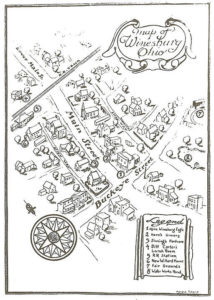
Map of Fictional Wineburg, Ohio from the first edition of Sherwood Anderson’s book “Winesburg, Ohio” (New York: B.W. Huebsch, 1919).
A century later, Winesburg, Ohio, is considered a modern classic. It owes its longevity not to shock value but to how astutely it portrayed a society on the cusp of colossal change. At a time when political upheaval has brought attention to small towns in the American Midwest, architect and Harvard Graduate School of Design professor Pier Paolo Tamburelli took Clyde, Ohio, as a case study for the Department of Architecture studio
“American Gothic, Monuments for Small-Town Life.” Under his supervision, the course created a design hypothesis for a new church in Clyde, exploring the role of architecture in communities that feel they’ve been abandoned and yet recur as a major motif in the American imagination.
“I wanted to ask the students to design a building with a social role, and then I had to accept that in this context the only realistic option was a church,” says Tamburelli, who co-founded Italian architecture office
baukuh. He encouraged students to design a simple architectural object knowing that, in the end, “a building is a building.” But he wanted them to know that a building is also an opportunity for a reflection on what he described as “the supreme indifference to space of the American Protestant tradition” in an essay published in Cult and Territory. Here, Tamburelli speaks of the enduring relevance and intrigue of towns such as Clyde and to what extent context should lead creativity when designing public projects for them.
How did your investigation of the American church come about?
Maybe we can start with a relatively simple, even banal observation: I’m from the countryside in northern Italy, so I’m familiar with provincial places. In a way, they all look the same. And I had been teaching in Chicago prior to Harvard, so I’m also familiar with the Midwest. Of course, the implicit background for the studio is the fact that Donald Trump was elected president of the United States, in part by exploiting a sense of abandonment in a large segment of impoverished white Christians, who used to consider themselves the “silent majority” and just discovered they are no more.

Wyeth, W. (1947). Dodges Ridge.
I thought, “How are these communities actually operating? And how, at least in theory, is it possible to overcome a loss of social fabric in these contexts?” So we went to take a look, and decided to focus on Clyde, Ohio. I read Sherwood Anderson’s Winesburg, Ohio. The fictional Winesburg is based on Clyde. Nowadays it has 5,000 inhabitants, more or less, and there’s a gigantic factory producing Whirlpool washing machines. Our studio went to Clyde; we talked to the mayor and saw the different congregations. I think the perception of the people we spoke to was that we were maybe a bit strange, but sincerely interested. We also went to visit some extremely good architecture that has been realized in that region in the last 50 years.
What drew you to the region from an architectural perspective?
Probably the building that we were the most interested in was the
Calvary Baptist Church by Gunnar Birkerts. It’s an orange hybrid—in between a pyramid and a barn—that somehow landed in the suburbs of Detroit. We met Lawrence T. Foster, an African American pastor who majored in theology at Harvard, who was an excellent guide into understanding the story of that specific congregation—its role in Detroit and so forth. We also went to Birkerts’s Law Library in Ann Arbor, which is amazing. It was a bit of a Gunnar Birkerts celebration tour.
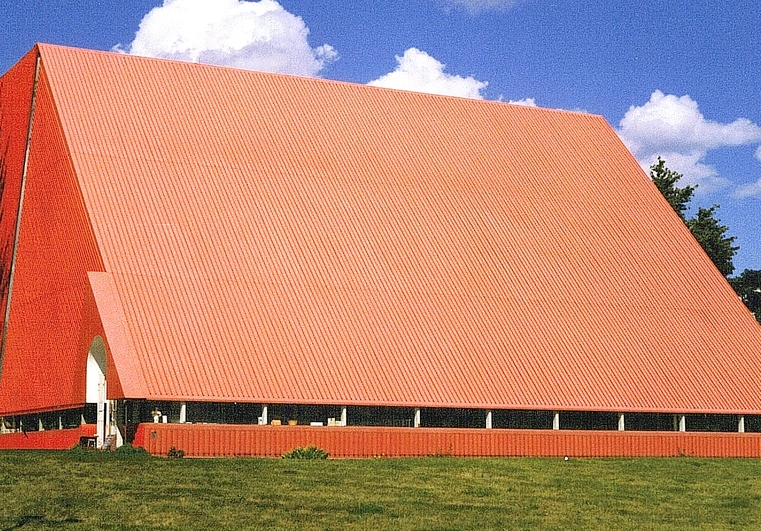
Gunnar Birkerts, Calvary Baptist Church, Detroit. Image by Anthony Lockhart.
I have no idea. I have no theory on churches. I suspect that churches are just buildings like others. They should be convincing as buildings, as architecture. Maybe a church should be capable of suspending the everyday preoccupations—at least for a little bit—and creating a space for something else. Actually, the church as a religious institution was not so important for the studio. I just wanted the students to design a public building in Clyde, and a church was the simplest possible public building in that context. (The only other option was a school, there’s not much else.) I also wanted to avoid a discussion over whether the church should be Catholic or Protestant, or whether it would be better to do a mosque or synagogue because that was not really the scope. I was not so interested in the church as a building, or as a religious experience, but as a place to build a community. I looked for a mainstream Protestant congregation, and we ended up with Methodist.
You were thinking about a disenfranchised, white, Christian minority, as you described it, and you wanted your students to design churches that could rekindle a sense of community…
These things provide background, but they are not a direct input for design. In a way it is not possible to design something like that. It is not possible to rebuild a community by means of architecture. So we moved from the larger investigation of the cultural landscape to the strictly disciplinary. To do that, I asked the students to design the church simply as architecture. The way in which the students would take a position on the wider cultural subjects should pass through the simple fact of designing a church. The studio was an interesting combination: on one side, trying to use architecture as a tool to explore a place and a culture, and on the other side, taking a very strict disciplinary approach to architecture.
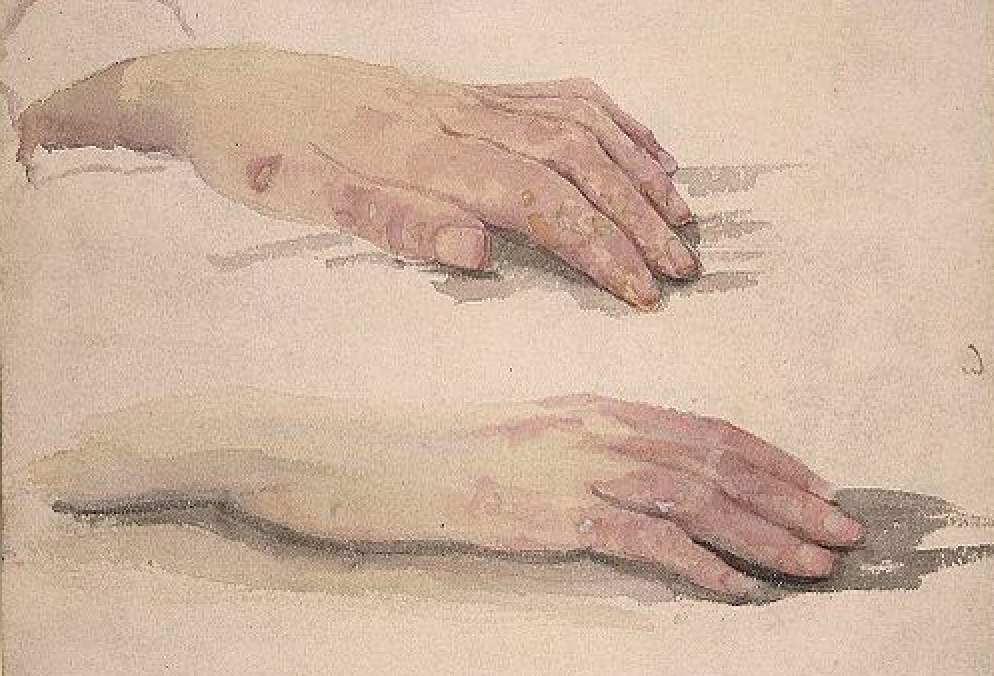
From Hands, Concerning Wing Biddlebaum from Sherwood Anderon’s “Winesburg, Ohio” (1919).
In the studio, we discussed a tradition of Europeans coming to America and often being fascinated by these vast, sparsely populated expanses at the center of the country. I tried to be honest in declaring my position as a European who looks at America that way.
I mean, if you’re Italian, the size of the American Plains or the Midwest is incredible. You come from this densely populated country where everything was already settled 2,000 years ago—where every corner has been reshaped, every hill has been polished through ages of adjustments. And then you get to this new landscape where everything is, first of all, so much bigger. The landscape is familiar because it’s the countryside, and also because you saw it in so many American movies while growing up in Italy. And yet there’s something that doesn’t exactly match up. It’s very difficult to describe because it is a sort of a gray area: you are not capable of seeing what is different, so you cannot give it a name. People who came to the US from Europe tried to replicate what they left behind. In Ohio or Iowa, you have these barns that are so-called Dutch, but they really don’t look Dutch.
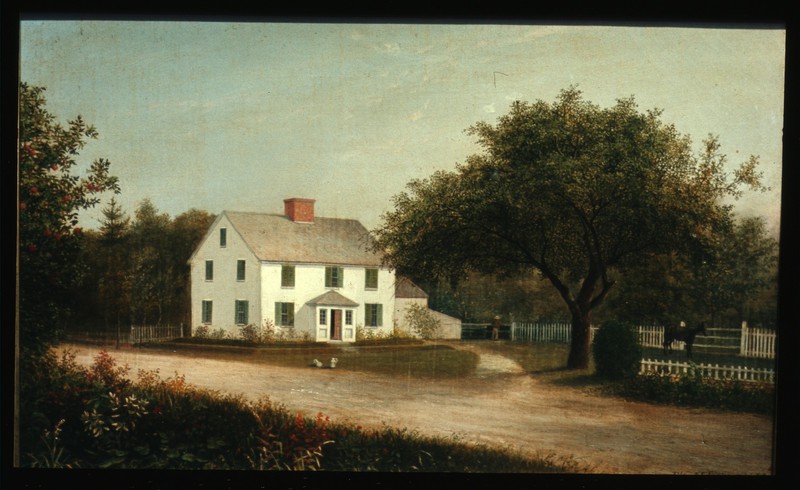
Lane, L, Old Stevens’ Homestead, Castine (1859).
We wanted to look at these social groups without coming to any final theory. We just tried to design buildings. That’s what we do. But we thought this was a phenomenon that was interesting and that it was, for a while, overlooked. And of course things are complex: the traditional Christian churches are certainly in a crisis. We didn’t know there was a schism brewing between two components of the Methodist Church, for example.
Did the designs of the buildings generated by students respond to the schism?
Sure. I think every student tried to fit the project into that context. Strangely, a lot of American students applied for this class. I think it somehow struck a nerve. Perhaps it was easier for me to do this than for an American teacher. Sometimes a bit of distance, even a bit of ignorance helps you. You don’t get scared by the complexity of the problem.
 These essays were meant as a provocation, a call to action. Now, during these times of dissonance, unrest, and uncertainty, their contents have become ever more important. For the next 26 weeks [starting June 15, 2020], the GSD and the Just City Lab will republish one essay a week here and at designforthejustcity.org. We hope they may continue conversations of our shared responsibility for the just city.
We believe design can repair injustice. We believe design must restore justice, especially that produced by its own hand. We believe in justice for Black Americans. We believe in justice for all marginalized people. We believe in a Just City.”
—Toni L. Griffin, Professor in Practice of Urban Planning, founder of the Just City Lab, and editor of The Just City Essays
These essays were meant as a provocation, a call to action. Now, during these times of dissonance, unrest, and uncertainty, their contents have become ever more important. For the next 26 weeks [starting June 15, 2020], the GSD and the Just City Lab will republish one essay a week here and at designforthejustcity.org. We hope they may continue conversations of our shared responsibility for the just city.
We believe design can repair injustice. We believe design must restore justice, especially that produced by its own hand. We believe in justice for Black Americans. We believe in justice for all marginalized people. We believe in a Just City.”
—Toni L. Griffin, Professor in Practice of Urban Planning, founder of the Just City Lab, and editor of The Just City Essays




















 These essays were meant as a provocation, a call to action. Now, during these times of dissonance, unrest, and uncertainty, their contents have become ever more important. For the next 26 weeks [starting June 15, 2020], the GSD and the Just City Lab will republish one essay a week here and at designforthejustcity.org. We hope they may continue conversations of our shared responsibility for the just city.
We believe design can repair injustice. We believe design must restore justice, especially that produced by its own hand. We believe in justice for Black Americans. We believe in justice for all marginalized people. We believe in a Just City.”
—Toni L. Griffin, Professor in Practice of Urban Planning, founder of the Just City Lab, and editor of The Just City Essays
These essays were meant as a provocation, a call to action. Now, during these times of dissonance, unrest, and uncertainty, their contents have become ever more important. For the next 26 weeks [starting June 15, 2020], the GSD and the Just City Lab will republish one essay a week here and at designforthejustcity.org. We hope they may continue conversations of our shared responsibility for the just city.
We believe design can repair injustice. We believe design must restore justice, especially that produced by its own hand. We believe in justice for Black Americans. We believe in justice for all marginalized people. We believe in a Just City.”
—Toni L. Griffin, Professor in Practice of Urban Planning, founder of the Just City Lab, and editor of The Just City Essays





